Insulation for Exterior Walls
Once Wojtek and Mark were done installing our continuous insulation on the exterior side of our Zip sheathing (4″ of Rockwool Comfortboard 80), including the first layer of battens (no more errant fasteners through the Zip to worry about), I was able to move inside and begin installing Rockwool Batts (R-23) in our 2×6 wall framing.
Once we had moved on from our first builder, and after reading up on the available options for insulation, we decided to invest in Rockwool insulation, both the rigid Comfortboard 80 on the exterior of our sheathing and the Rockwool batts for inside our stud bays. Although more expensive, particularly the Comfortboard 80 for continuous insulation (used rigid foam would’ve been substantially less expensive), we felt that many of its properties made it worth the added cost.
In particular, by helping our wall assembly to be vapor-permeable (or vapor open), we felt the Rockwool could help mitigate any mistakes, should they be made, in the wall assembly details. This being our first build acting as a GC, we wanted to add some margin for error wherever we could find it.
More details on our wall assembly and how we finalized details, including our desire to maintain a high level of IAQ, can be found here: Wall Assembly
For environmental reasons, one of our goals was to try and be as “foam free” as possible throughout the build. In addition, beyond just this issue regarding the use of foam (in all its forms: rigid board and sprayed varieties alike), there’s increasing awareness about the carbon footprint of our structures, not to mention the total carbon footprint of our daily lives.
At any rate, if I had it to do over, I would at least seriously consider using reclaimed rigid foam for our continuous insulation over the sheathing (both for the potential cost savings and its status as a reclaimed material otherwise headed for a landfill), understanding that it does reduce a wall’s ability to dry to the exterior. As others have noted, using reclaimed rigid foam in this way may be the best, or “greenest”, use of foam insulation until the construction industry hopefully moves beyond its use altogether as better options become more viable (e.g., wood fiber insulation).
Here are some resources for reclaimed rigid foam:
https://www.reuseaction.com/sales/foam/
https://www.greeninsulationgroup.com/
https://www.repurposedmaterialsinc.com/polyiso-insulation/
I would also consider using dense pack cellulose in the 2×6 walls instead of the Rockwool batts if I could find an installer I was reasonably certain could do the work properly. During construction it felt safer to use my own labor to install the Rockwool batts, thus avoiding the possibility of any gaps in the wall insulation. I was hoping to offset the cost of the batts with my free labor, plus I just enjoyed doing the work. Had we gone with the dense pack cellulose, it would’ve been something I couldn’t do on my own (no equipment or training).

Installing the Rockwool batts is fairly easy and satisfying work. They’re much easier to work with than fiberglass batts, which are horrible on your skin and tend to flop around as you try to get them into place. While the Rockwool also produces some irritating fibers when it’s cut (and requires a dust mask like fiberglass), I found that a shower easily washed them away. Wearing long sleeves during installation also easily mitigates this issue.
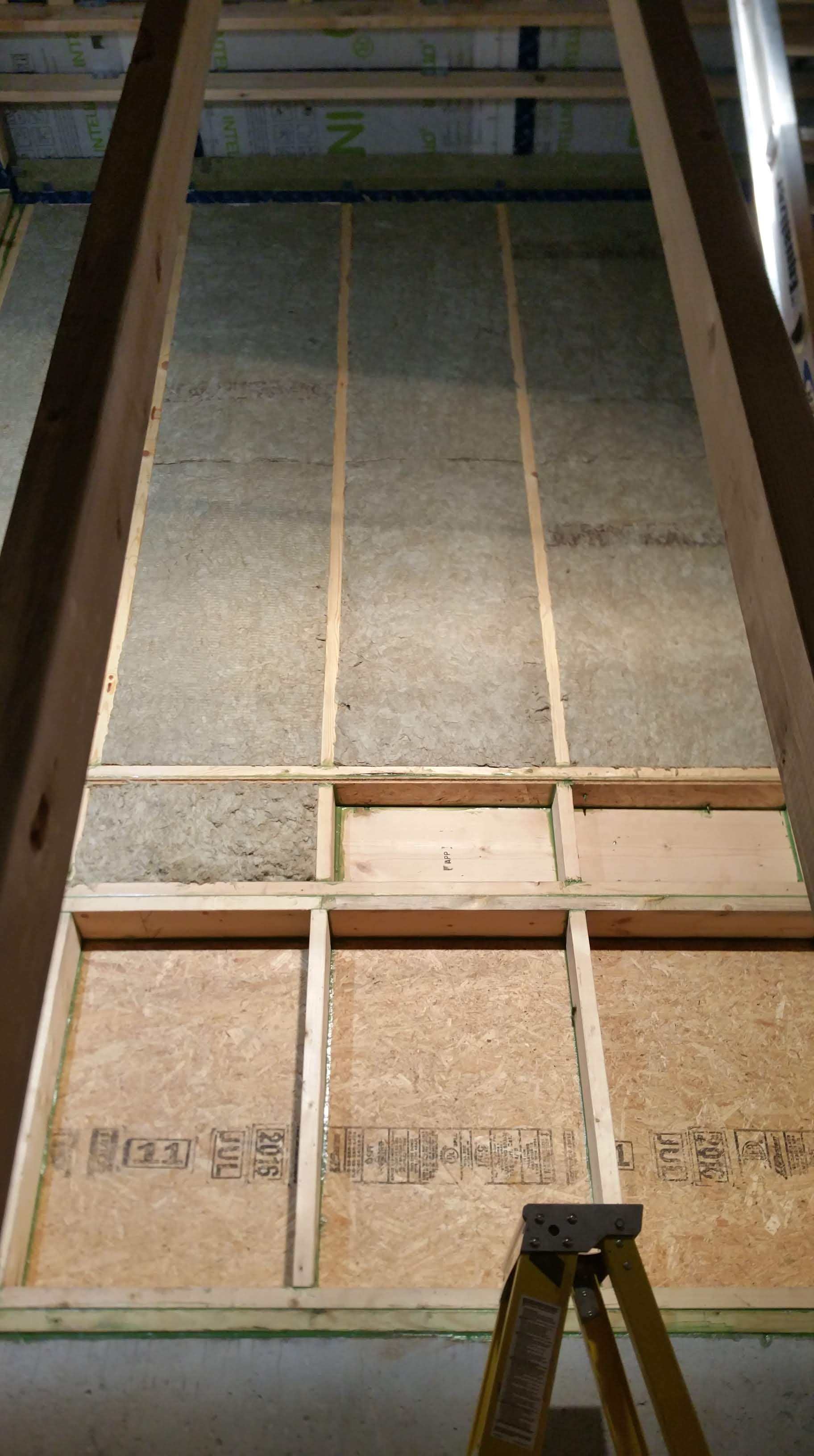
Also, the fact that the Rockwool batts have a friction fit means they don’t require any additional staples or netting to get them to stay put once installed.
Because of the friction fit, it’s also easy to tear off small pieces to stuff into irregular shaped voids should the need arise.
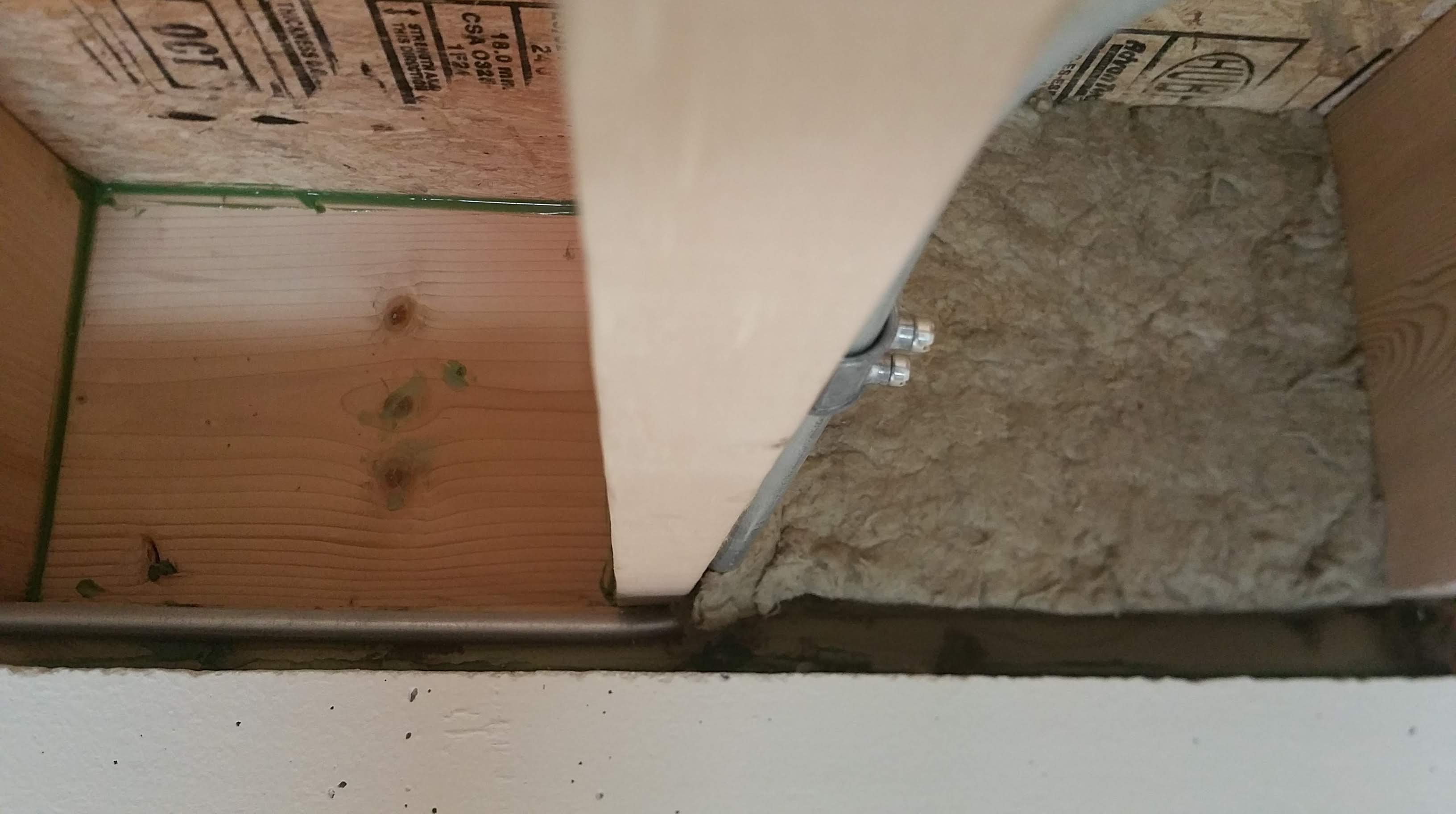
Like the Comfortboard 80, the batts can have some variation from one piece to another, with a change in the amount of density clearly visible. With the Comfortboard 80, this was significant enough that we avoided using the worst pieces, meaning those with the least amount of density (these pieces felt thinner and sometimes even crumbly). Although this inconsistency was still present in the batts, I managed to use almost every piece, saving the least dense pieces for use in some interior walls for sound attenuation (more on this topic below).
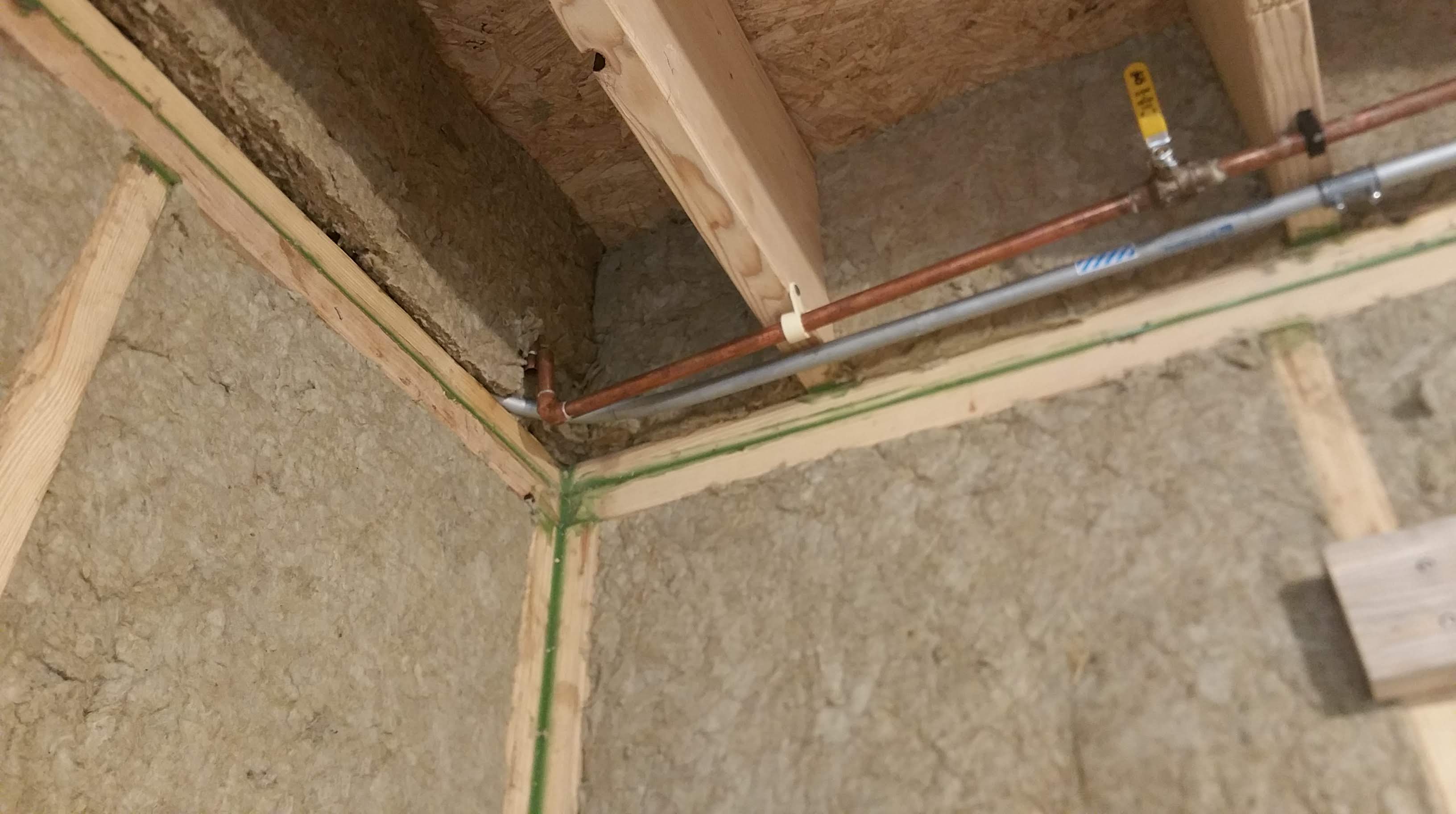
Overall, we were happy with the Rockwool batts, and would definitely use them again should dense pack cellulose not be a viable option. They’re also ideal for a self-build since anyone who’s reasonably handy can install them should they have the time available during construction.
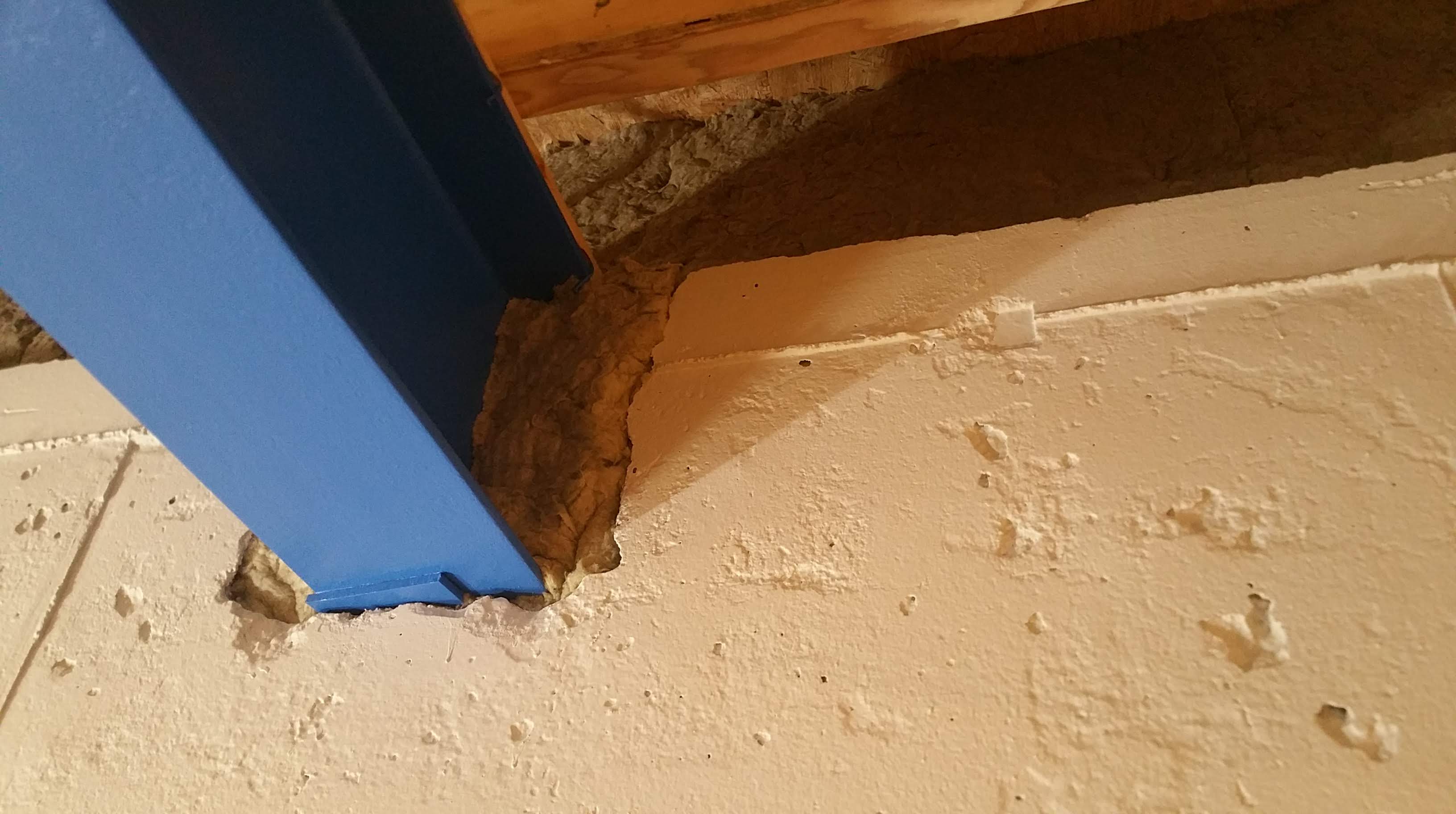
In conjunction with the Intello that would eventually be installed over the 2×6 framing members and the Rockwool batts, we also used Flame Tech putty pads to air seal behind every outlet and light switch box. I had seen them used in a Matt Risinger video for sound attenuation:
The other option would’ve been to use airtight junction boxes. Here are a couple of examples: Small Planet Supply and 475HPBS.
In order to limit issues with all the air sealing I was doing, I tried to stick with products my subcontractors already used everyday. As a result, since my electrician wasn’t familiar with airtight junction boxes, I opted instead to come in after he had everything installed and apply the putty pads. I found installing them to be straightforward and pretty quick.

The putty pads are attached to release paper. Once the paper was removed the pads were easy to mold around each outlet and light switch box.

Here’s a completed outlet box:
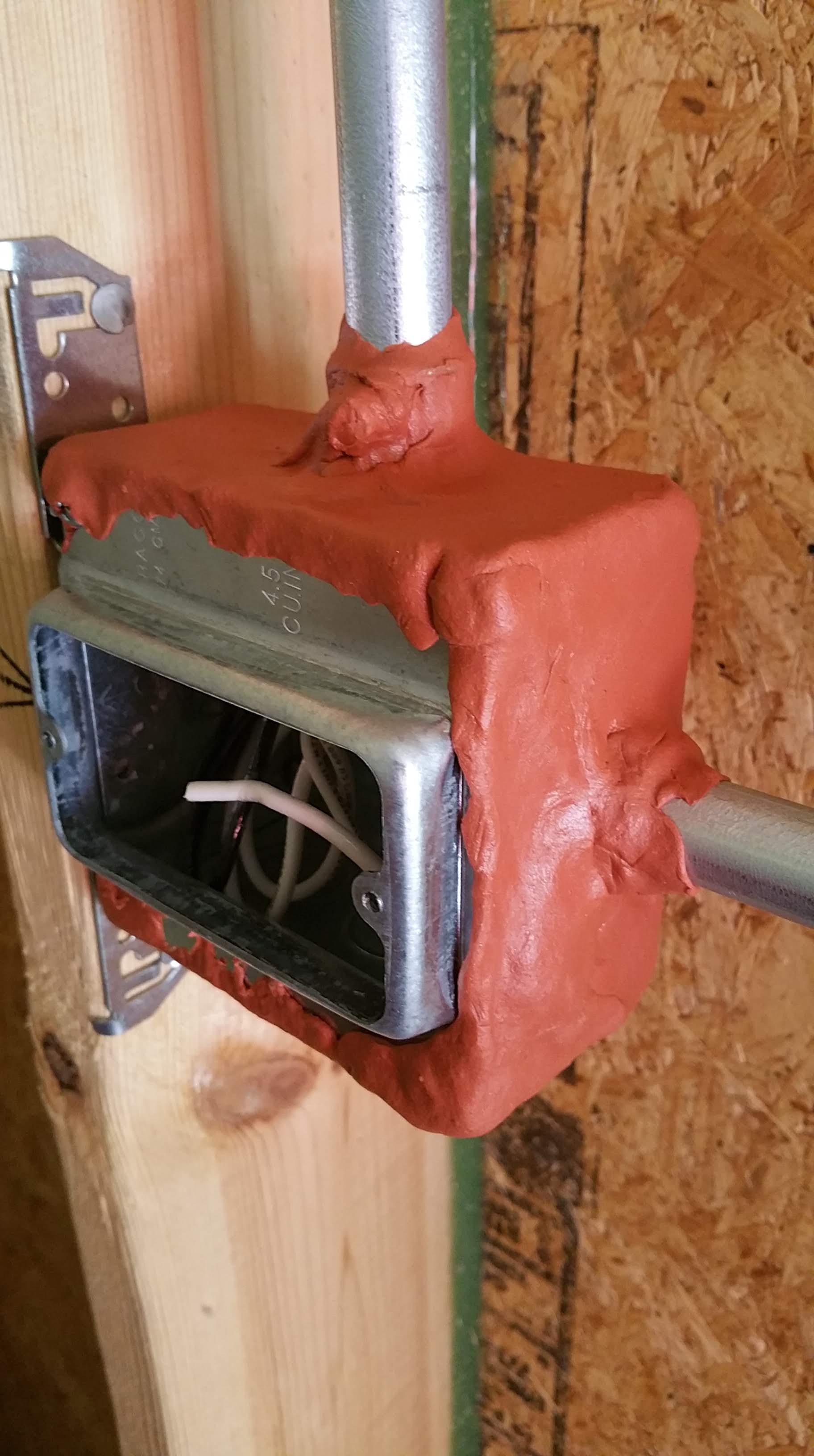
The trickiest area to detail for the walls was at the ceiling and wall junction. In our case, the roof trusses sit on 2-2×6’s turned on their sides, which sit on top of the wall’s double top plate. The 2-2×6’s create space for our service cavity under the bottom chord of the roof trusses.
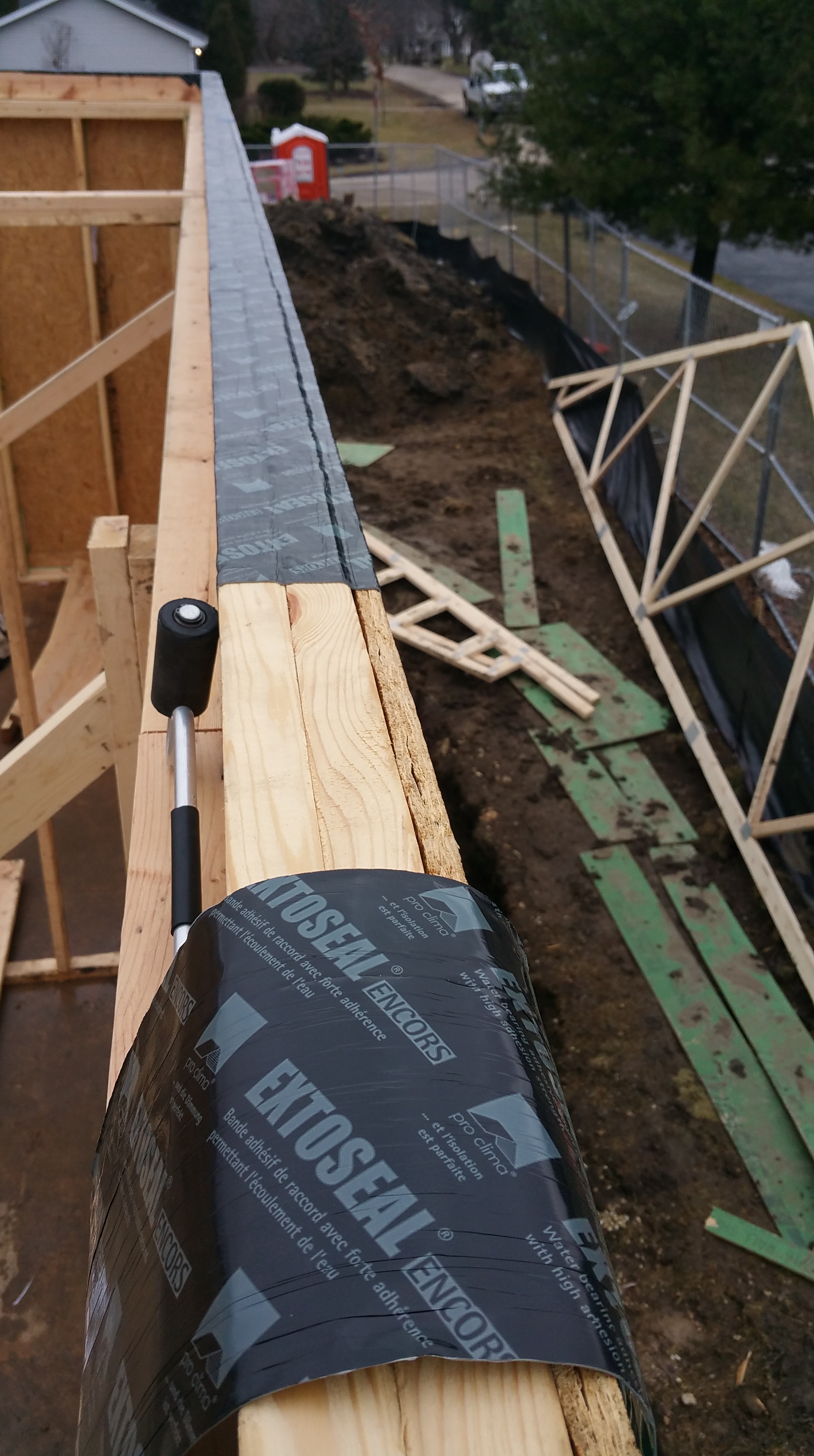
Before cellulose could be blown into the attic, we installed Intello to the bottom chord of the roof trusses. At all outside edges the Intello was carried from the roof trusses down over the double top plates of the walls, anticipating the Intello eventually being installed on the walls, which required a connection point between the Intello on the ceiling and the Intello on the walls.
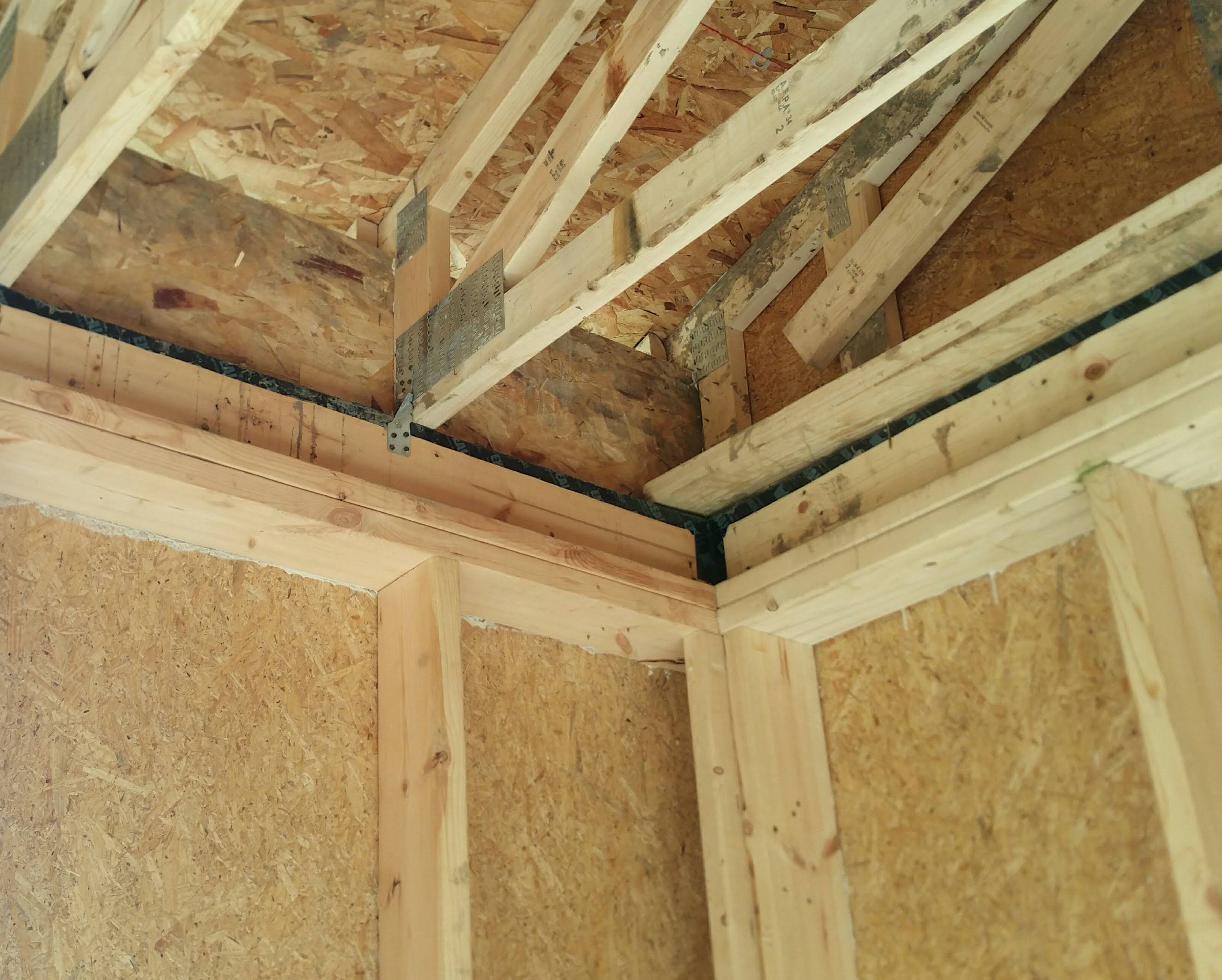
After the Intello was installed on the ceiling, a service cavity (or service core, or service chase) was created with 2×6’s screwed to the bottom chord of the trusses through the Intello.
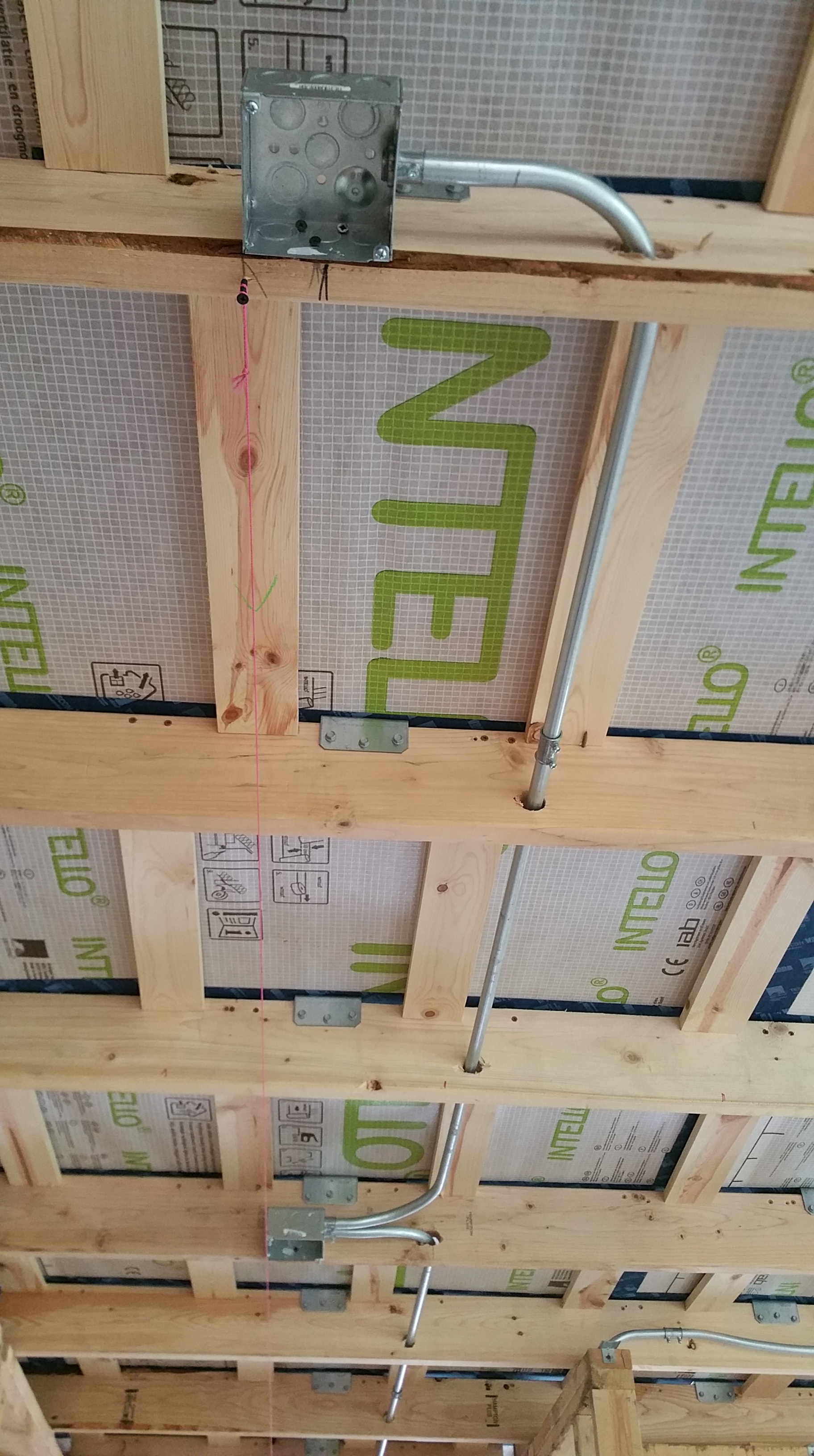
This gap was going to be a dedicated space for lighting and the 3″ Zehnder tubes of our ERV (as things turned out, we didn’t end up needing this space for the Zehnder tubes).
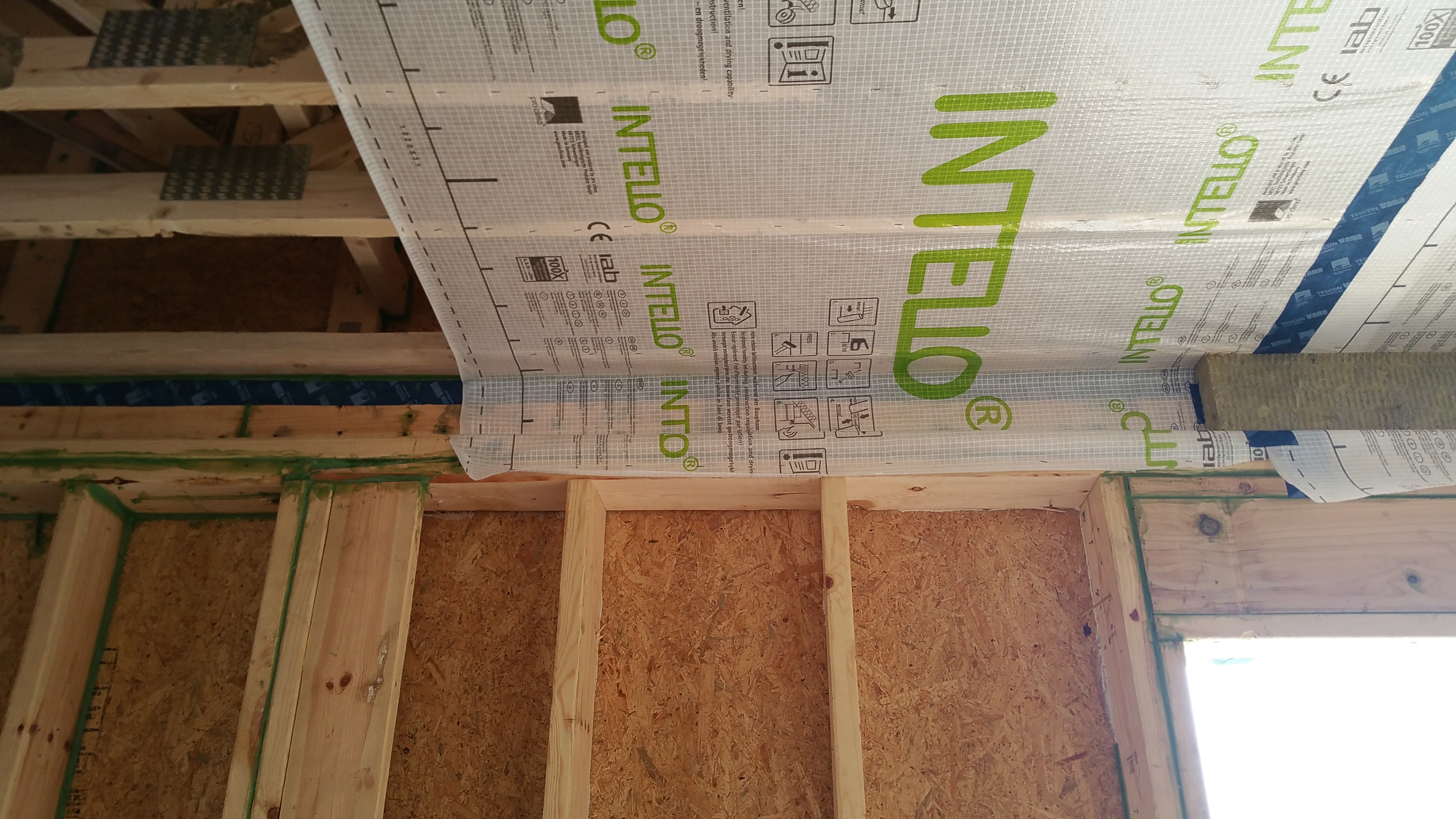
Before installing the Rockwool batts in the walls, I was also able to fill this gap created by the two 2×6’s on their side that sit on top of the double top plates with leftover pieces of Comfortboard 80. The first piece of Rockwool fit snug inside the gap, while the second piece was attached to the first with some plastic cap nails and the friction supplied by the 2×6’s forming the service cavity. Some additional holding power was added at the gable ends by utilizing drywall clips (visible in the photo below):
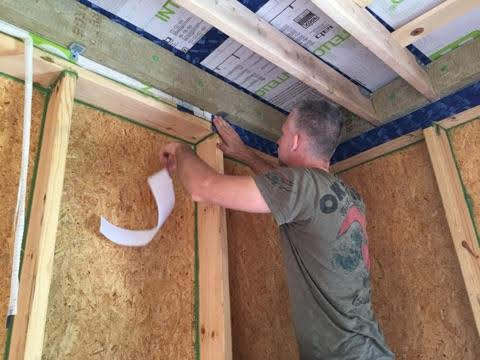
The drywall clips were helpful in lending support to drywall anywhere that adding solid blocking would be time consuming or a physical challenge.
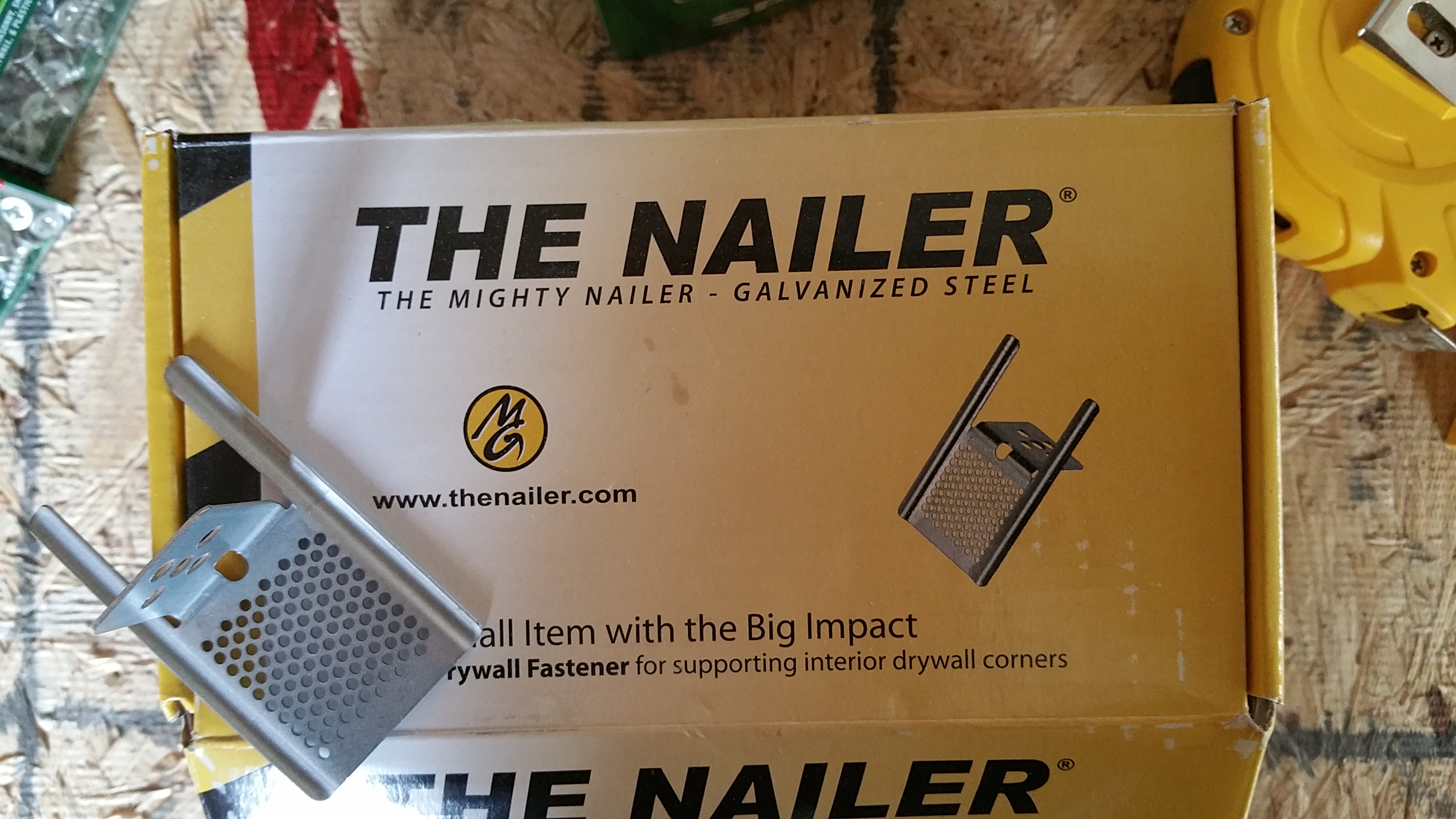
Even though we utilized a 12″ raised heel roof truss, and we had 4″ of Rockwool on the exterior of our Zip sheathing, it was important to fill this gap created by the service cavity to make sure our thermal layer was unbroken around the perimeter of the house (4″ Rockwool on the exterior, 5 1/2″ Rockwool in the stud bays). The outside edge of the roof truss is also the most vulnerable to ice damming, so having the 4″ of Rockwool Comfortboard 80 directly below this area where blown-in cellulose would be installed offers some additional thermal performance to the attic insulation.
Another view of this area where roof truss meets the 2-2×6’s standing on their side, creating a gap between the bottom chord of the roof truss and the top plates on the wall below.
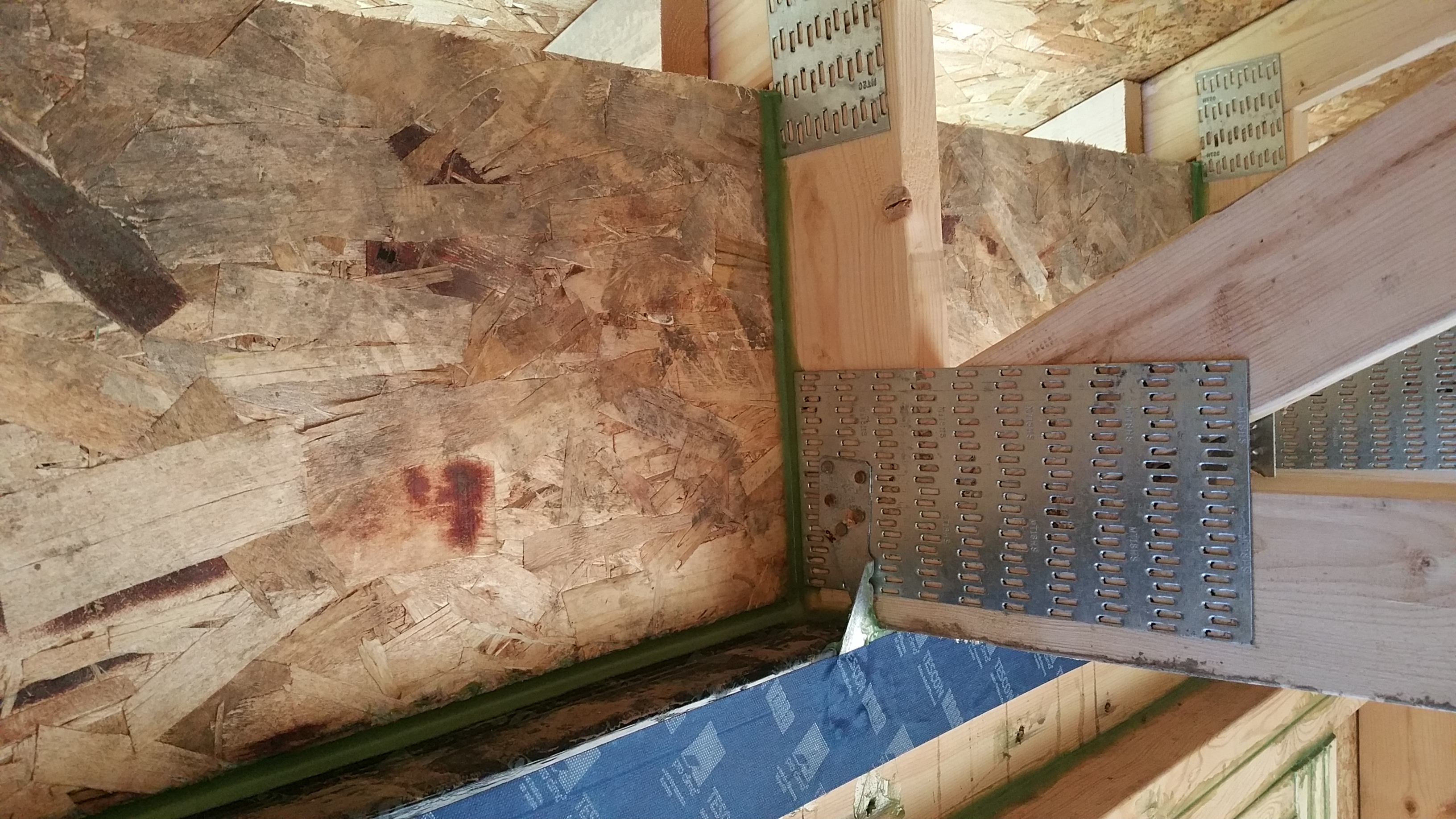
If I had it to do over, I would go with a 24″ raised heel truss, as this would offer not only significantly more R-value in this area (for relatively little expense), it would also make any inspection or repairs in this area much easier to deal with.
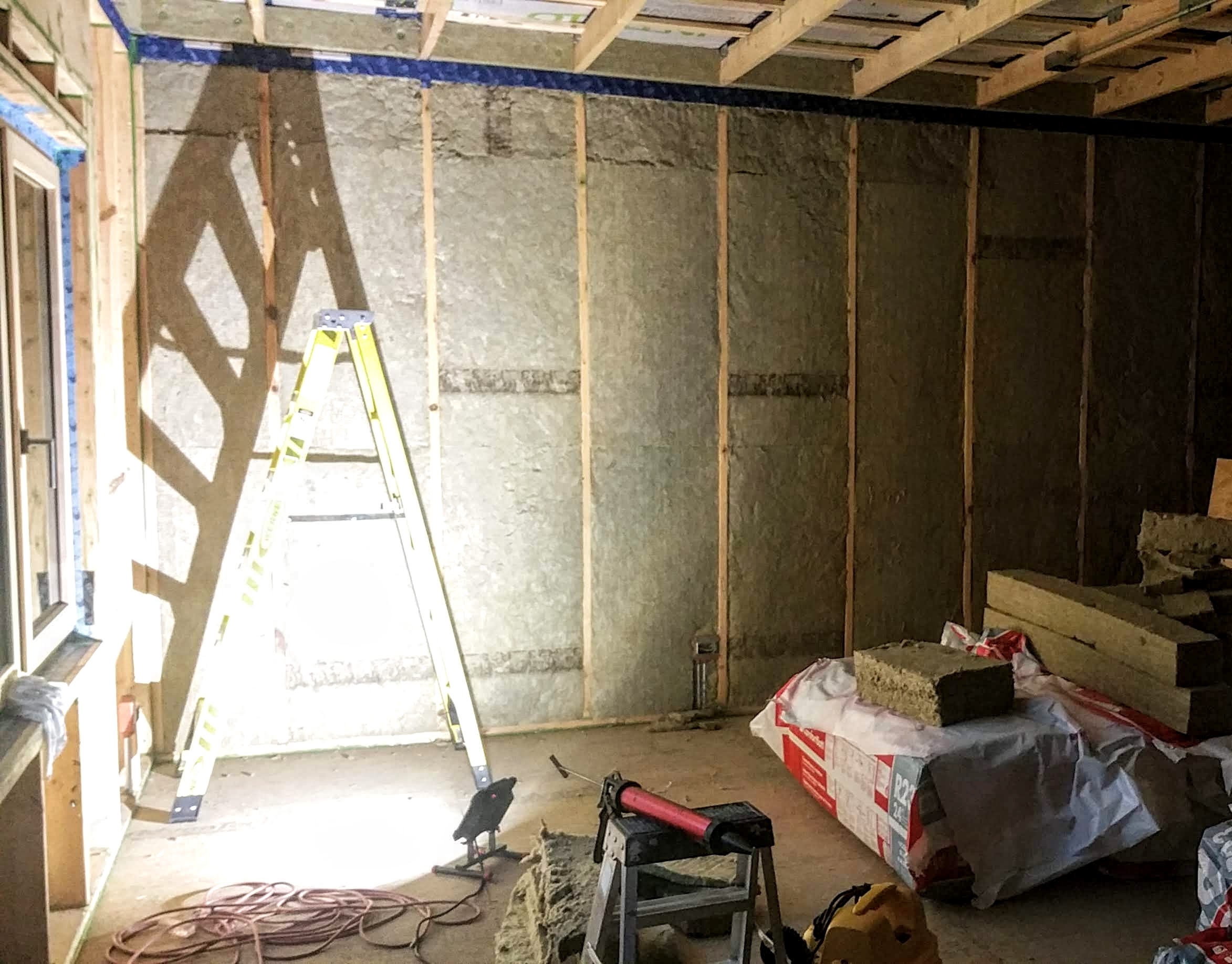
As each piece of Rockwool batt was installed, it was important to keep any butt joints between cut pieces tight together. Also, once each piece was snug inside the stud bay I finished by gently fluffing the outside perimeter edges so the Rockwool sat as flush as possible to the 2×6 studs, thus maximizing their R-value.
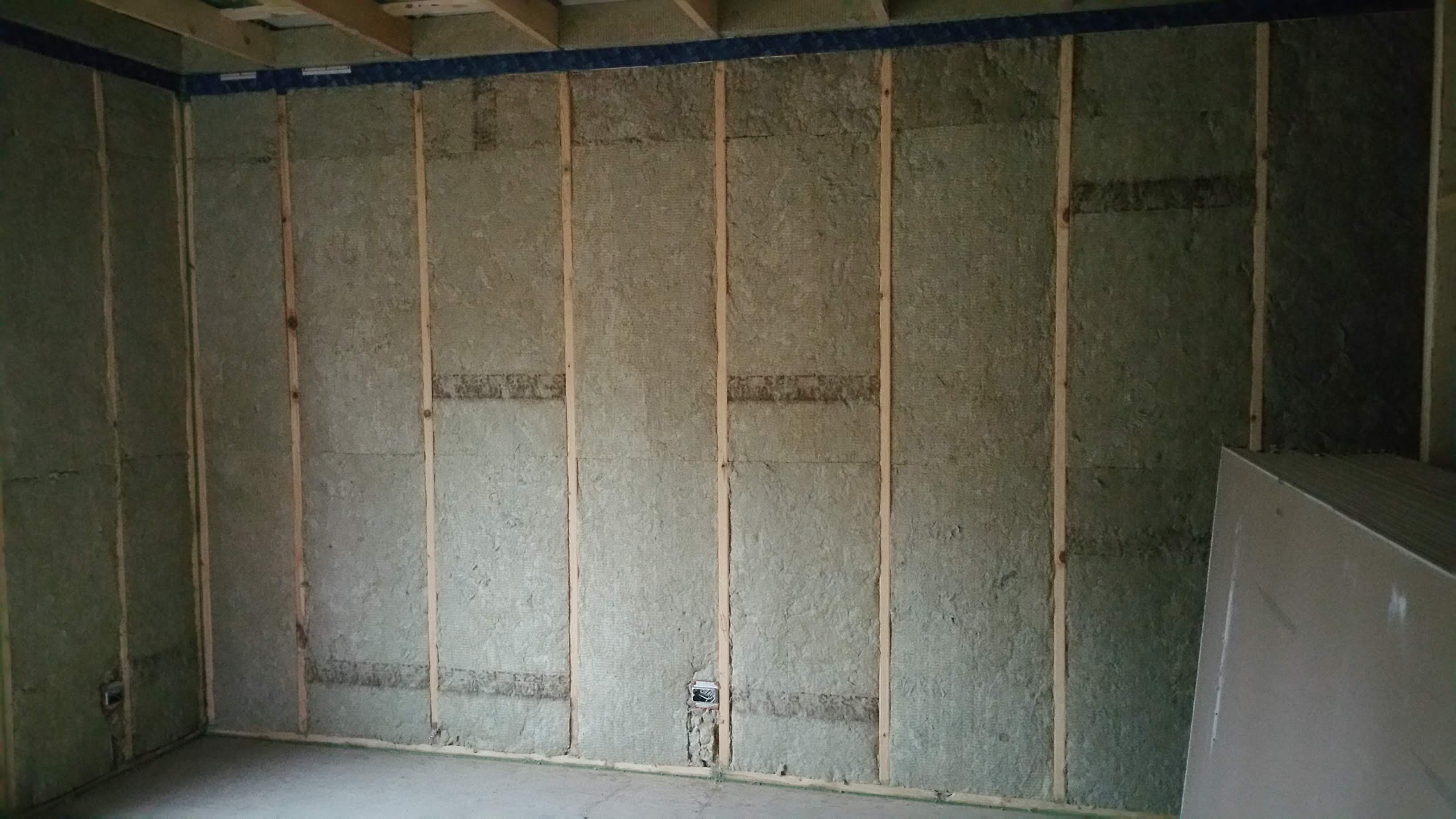
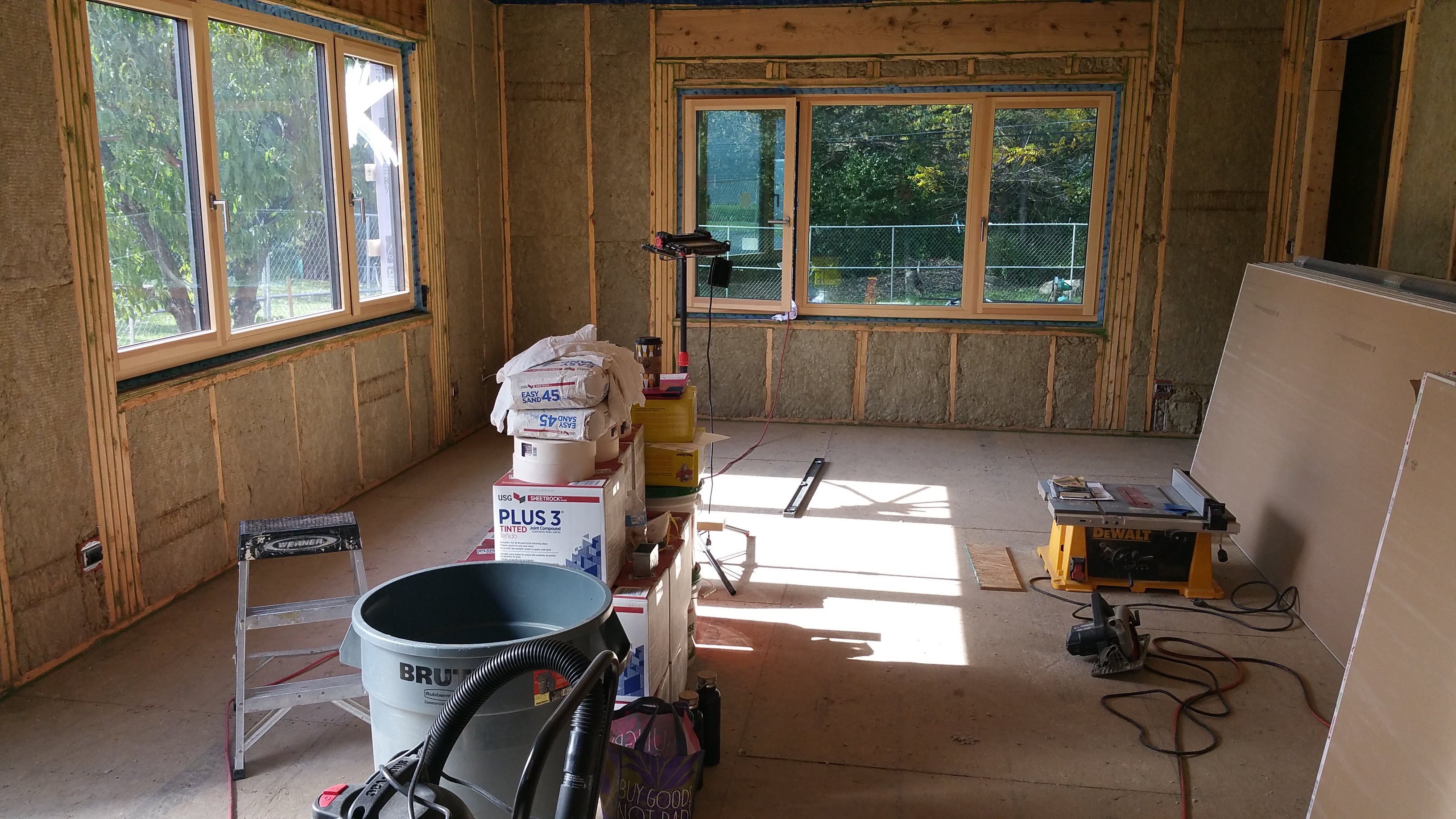
Intello
With 4″ of Rockwool Comfortboard 80 on the exterior of our sheathing, the code specifies that we could’ve just used latex paint as our interior vapor retarder (Class III).
Again, to improve our margin for error, I felt like it was worth the added expense and time to install a smart vapor retarder (CertainTeed’s Membrain product would’ve been another alternative) to avoid potential issues with diffusion in the winter.
When I asked a question on GBA about this issue, the consensus seemed to be that the Intello, although technically unnecessary, was a nice bit of insurance.
It also added a final layer to all of the previous air sealing details. With redundant layers of air sealing, even if small areas experience failure over time, there are still other areas to back it up, thus maintaining our overall air tightness for the long term.
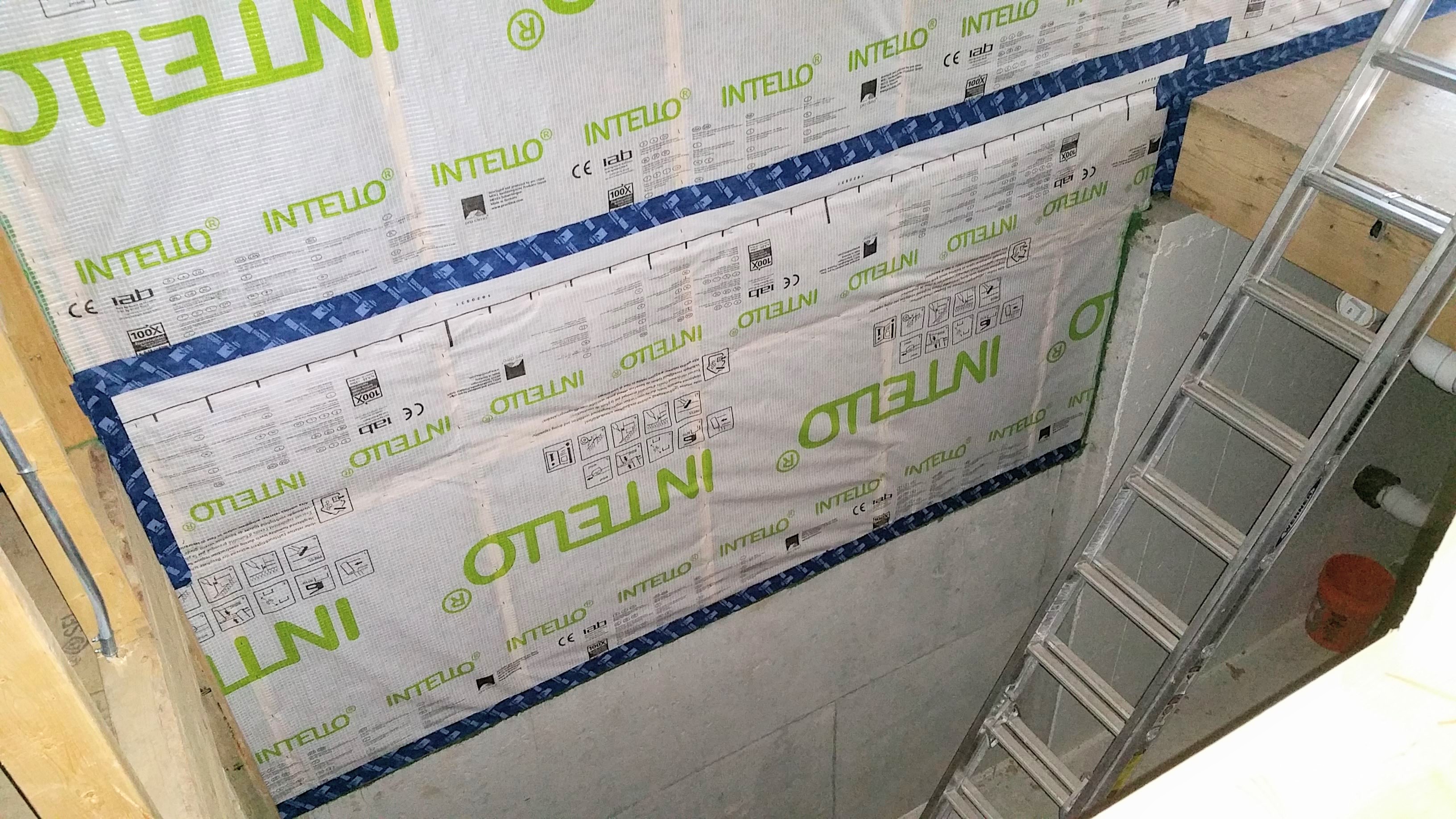
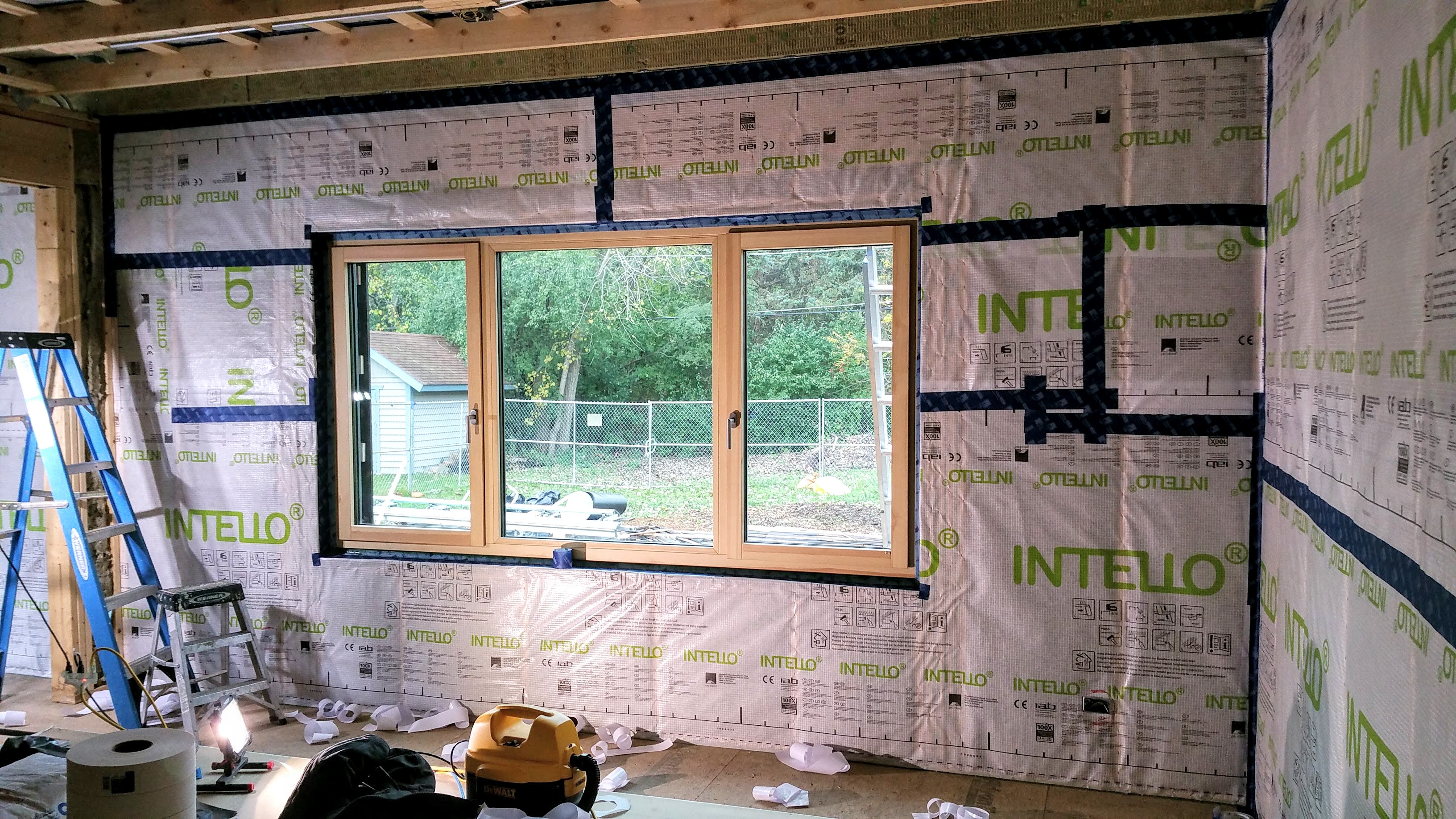
Sealing the Intello to the subfloor was one of the final air sealing chores of the build. It was deeply gratifying to finally get to this point, especially since drywall and then flooring were up next.
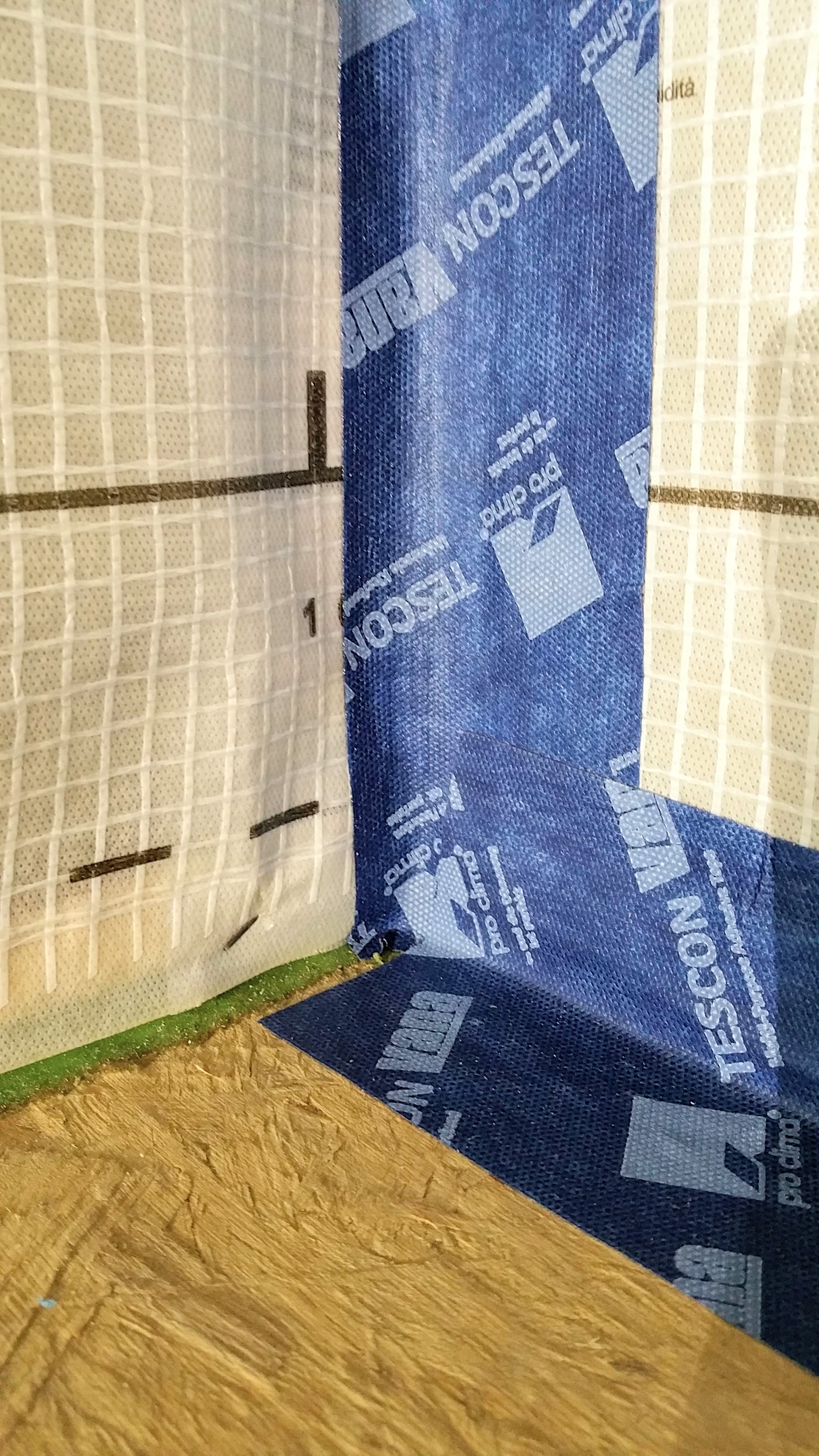
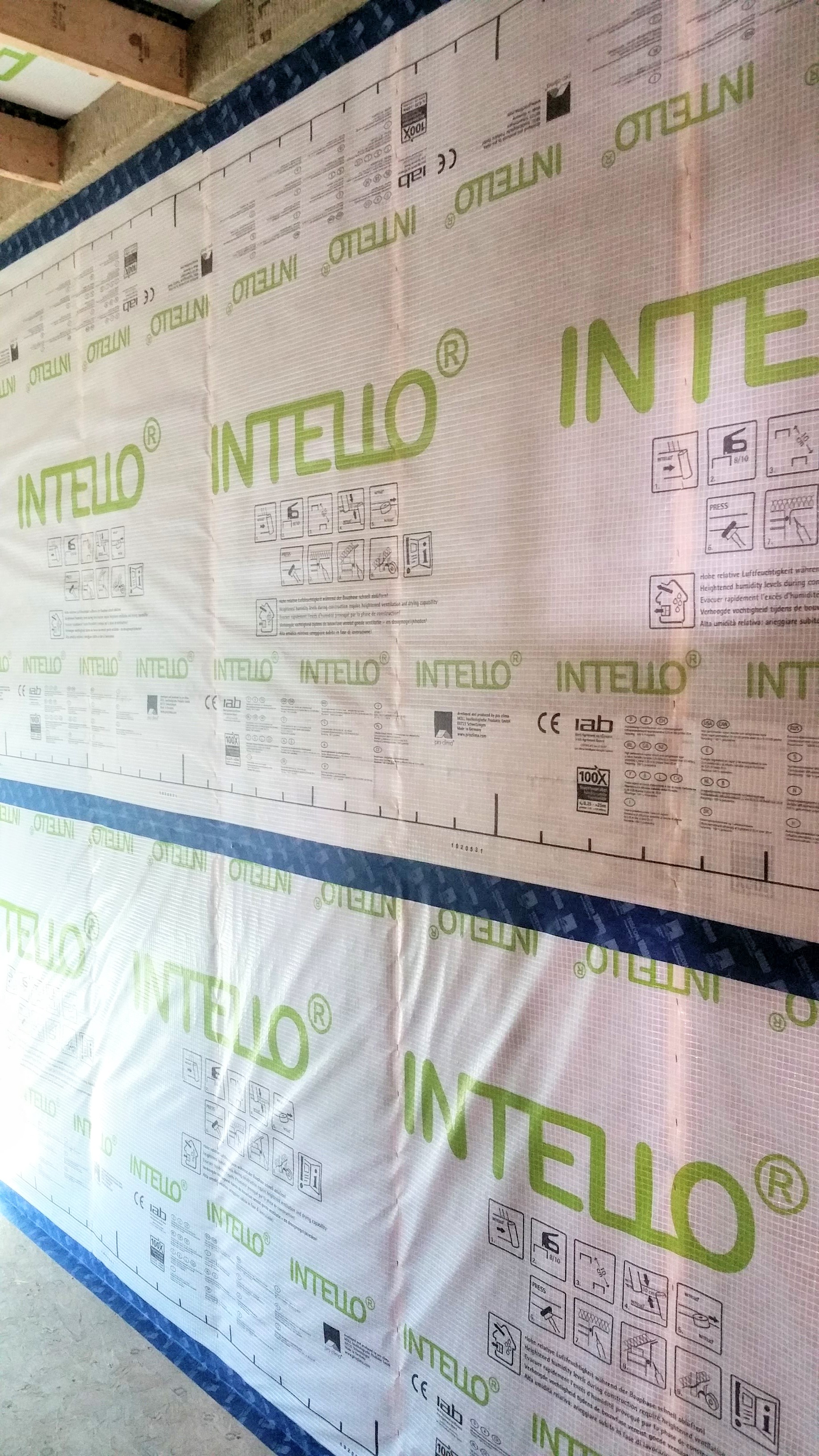
Thoughts on Advanced Framing Techniques
If I had it to do over, I would use less framing around windows and doors, along with using pocket headers instead of the more traditional insulated headers we ended up with. Pushing the header to the exterior sheathing would mean being able to insulate the pocket on the interior side with Rockwool or dense pack cellulose, rather than the rigid foam we ended up with (unfortunately, XPS in our case).

Before we had to fire them, the two GC’s we were still working with as framing began were unfamiliar with advanced framing techniques, and they were already struggling to comprehend the many Passive House details in the drawings (not to mention many of the conventional details) so, as I’ve noted elsewhere, I had to pick my battles carefully.
Another change I would make would be at points where interior walls meet up with exterior walls. Rather than using ladder blocking to make the connection, which is still better than more traditional methods (creating a boxed in void that’s virtually impossible to insulate), I would utilize a metal plate at the top of the walls to make a solid connection. In addition to making drywall installation easier since it would create space between the two intersecting walls for sheets of drywall to be passed through, it would also make installing insulation, especially batt insulation, much more straightforward with clear and easy access (no horizontal blocking to get in the way).

A ProTradeCraft article discusses what builder David Joyce believes is ‘worth doing’ in terms of advanced framing techniques. Perhaps just as important, he points out what he believes can be safely ignored, or is just ‘not worth doing’ when it comes to OVE.
In this Matt Risinger video, architect Steve Baczek delves into some of the key components he uses to optimize advanced framing techniques:
In addition to the pocket headers, the idea of using header hangers instead of additional jack studs, seems to make a lot of sense.
And here’s a ProTradeCraft video regarding their own take on Advanced Framing:
One final change to our framing would be opting for 2-stud corners instead of the California 3-stud corners that we have. Although a relatively small change, I think a 2-stud corner is cleaner and allows for slightly more insulation in this vulnerable area.
Clearly each designer, architect, GC, or framing crew will have their own particular views on advanced framing, so there’s room to make individual choices without undermining the goal of balancing structural integrity with reduced energy demand. Local codes, along with the opinion of your rough framing inspector, will also have to be accounted for.
My guess is these techniques will continue to evolve, especially if specific products come to market to aid the process (i.e. reduce the amount of framing lumber required while ideally also lowering labor costs, all without negatively affecting the overall strength of the structure).

One final attempt at some additional air sealing was around outlet and switch boxes as they met up with the Intello. With a bead of HF Sealant, it was easy to make an airtight connection between the Intello and the box.
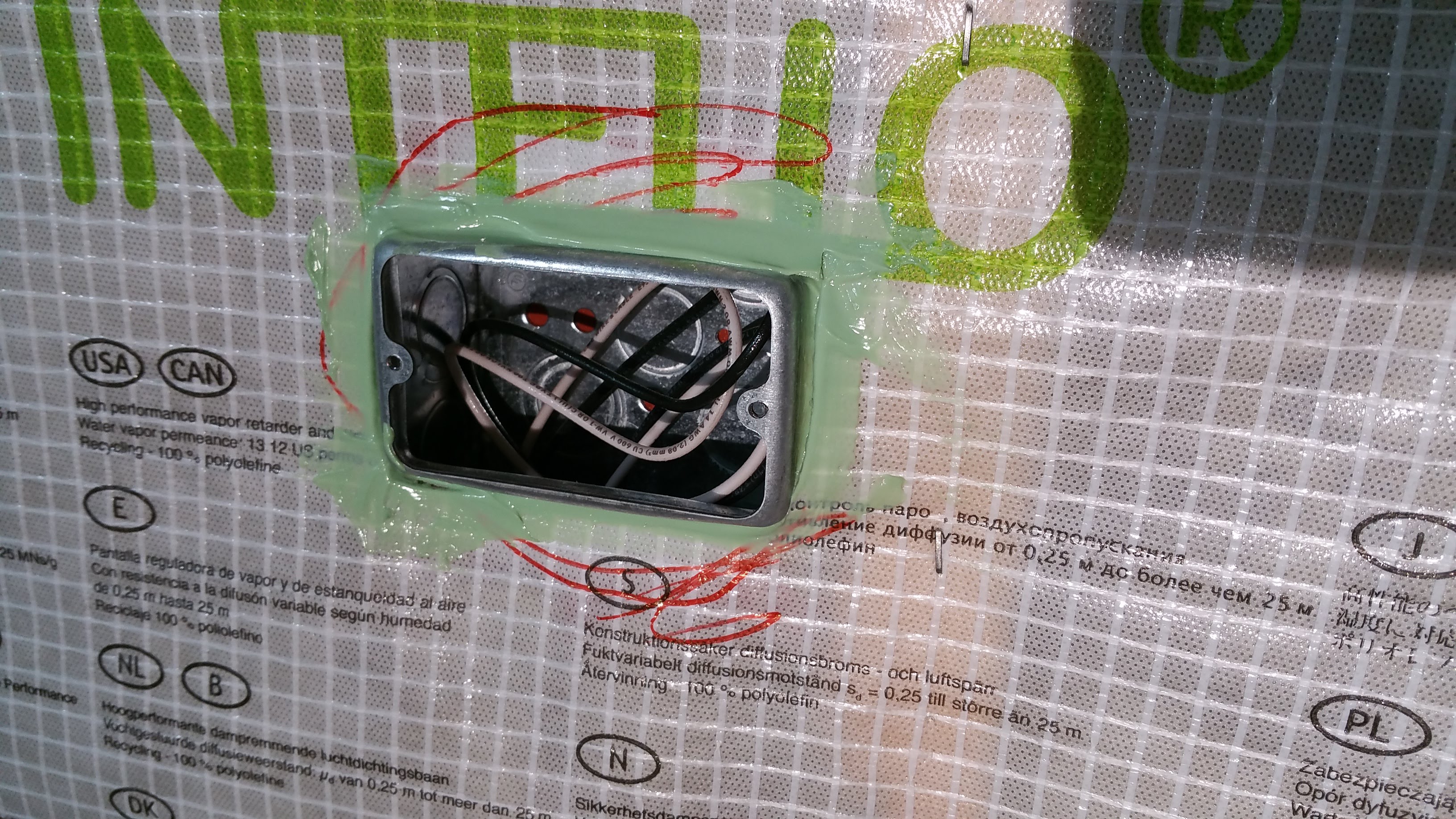
At doors and windows, I finished these areas off with a strip of Tescon Vana tape, just as I had at the top and bottom of the walls.
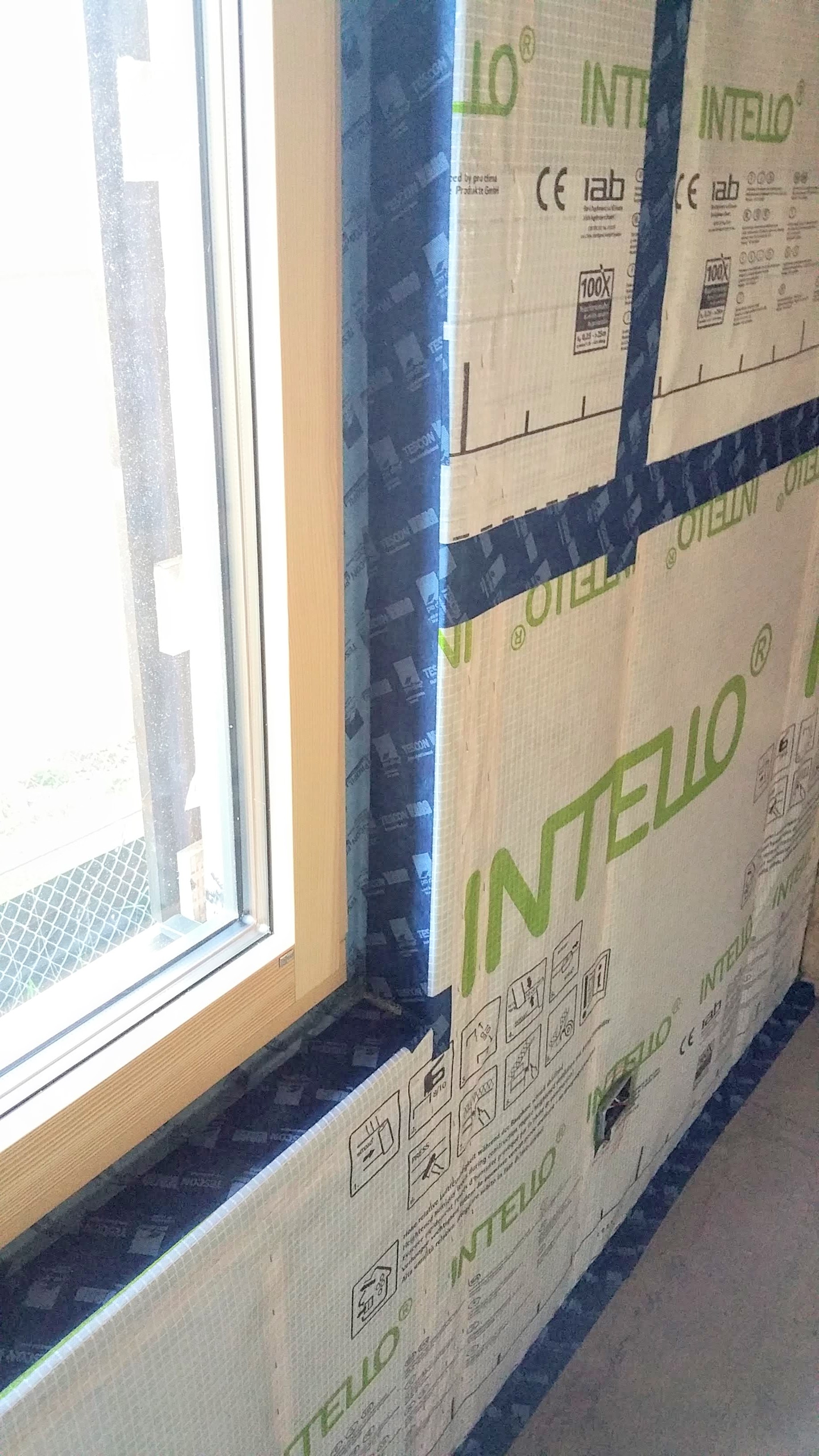
Because corners tend to be problematic in terms of air leakage, I also added a dab of HF Sealant to these areas for the sake of some added redundancy.
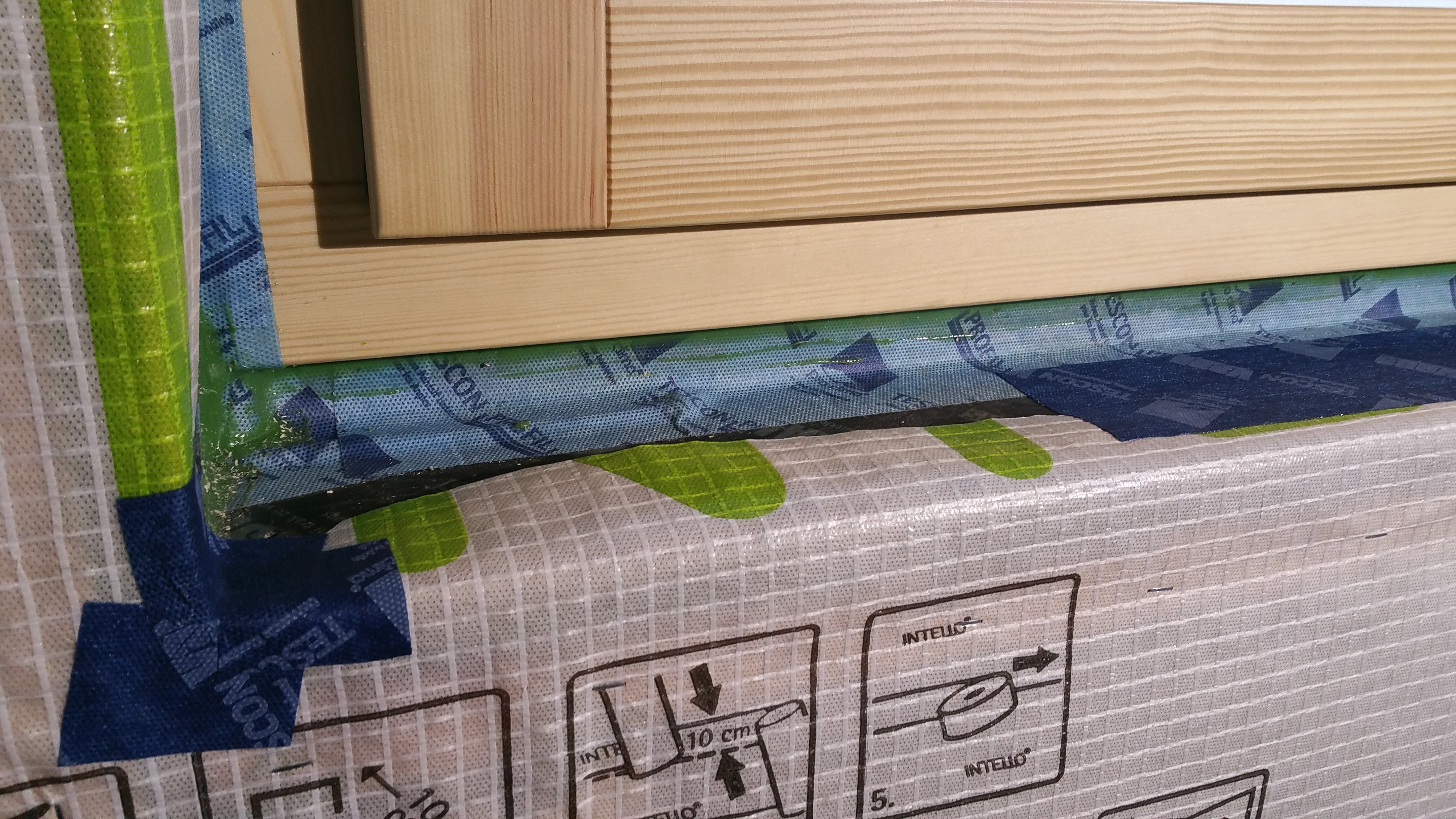
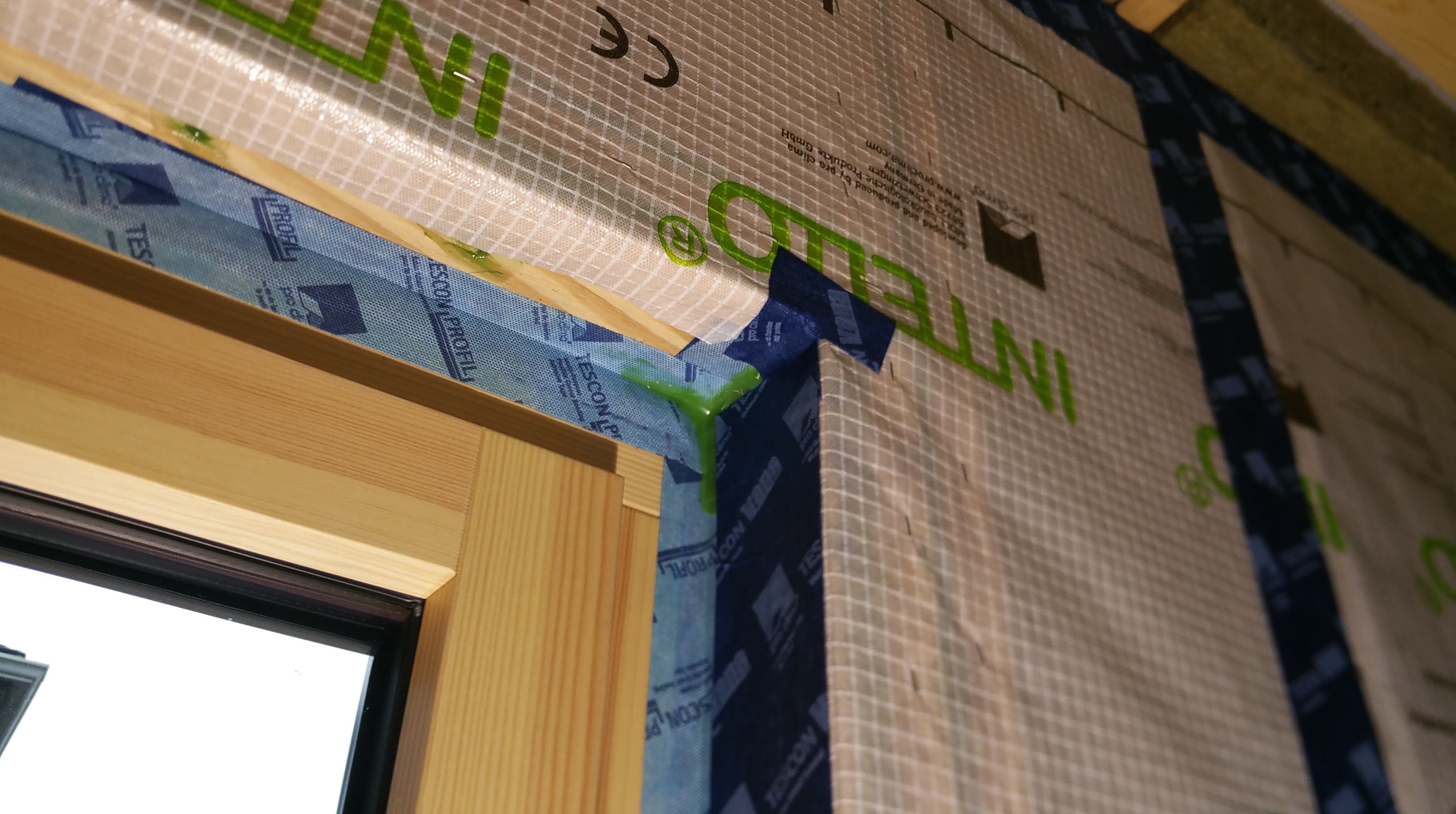
Sound Attenuation
Since we designed our home with a smaller than average footprint, incorporating many Not So Big House principles (roughly 1500 square feet for the main floor, with another 1500 square feet in the full basement below), one way to make the floorplan feel larger than it actually is was to provide some sound attenuation in key areas (we incorporated several other techniques to “expand” the feel of the floorplan that will be discussed in upcoming posts regarding interior design).
For instance, we installed the Rockwool in the long partition wall that runs east-west down the center of the floorplan. This wall helps define the barrier between public areas (kitchen and family room) on the south side of the home and the private areas (bathrooms and bedrooms) on the north side of the home.
We could’ve used Rockwool Safe ‘n’ Sound, but at the time, during construction in the fall of 2017, it was a special order item in my area, whereas the batts were already in stock, both for my main 2×6 partition wall, a 2×6 plumbing wall, and the remaining 2×4 walls that we felt could benefit from the Rockwool.
In the photo below, the Rockwool in the main east-west partition wall is covering the refrigerant and drain line for one of our three Mitsubishi heat pump heads, along with the usual electrical conduit for outlets and light switches.
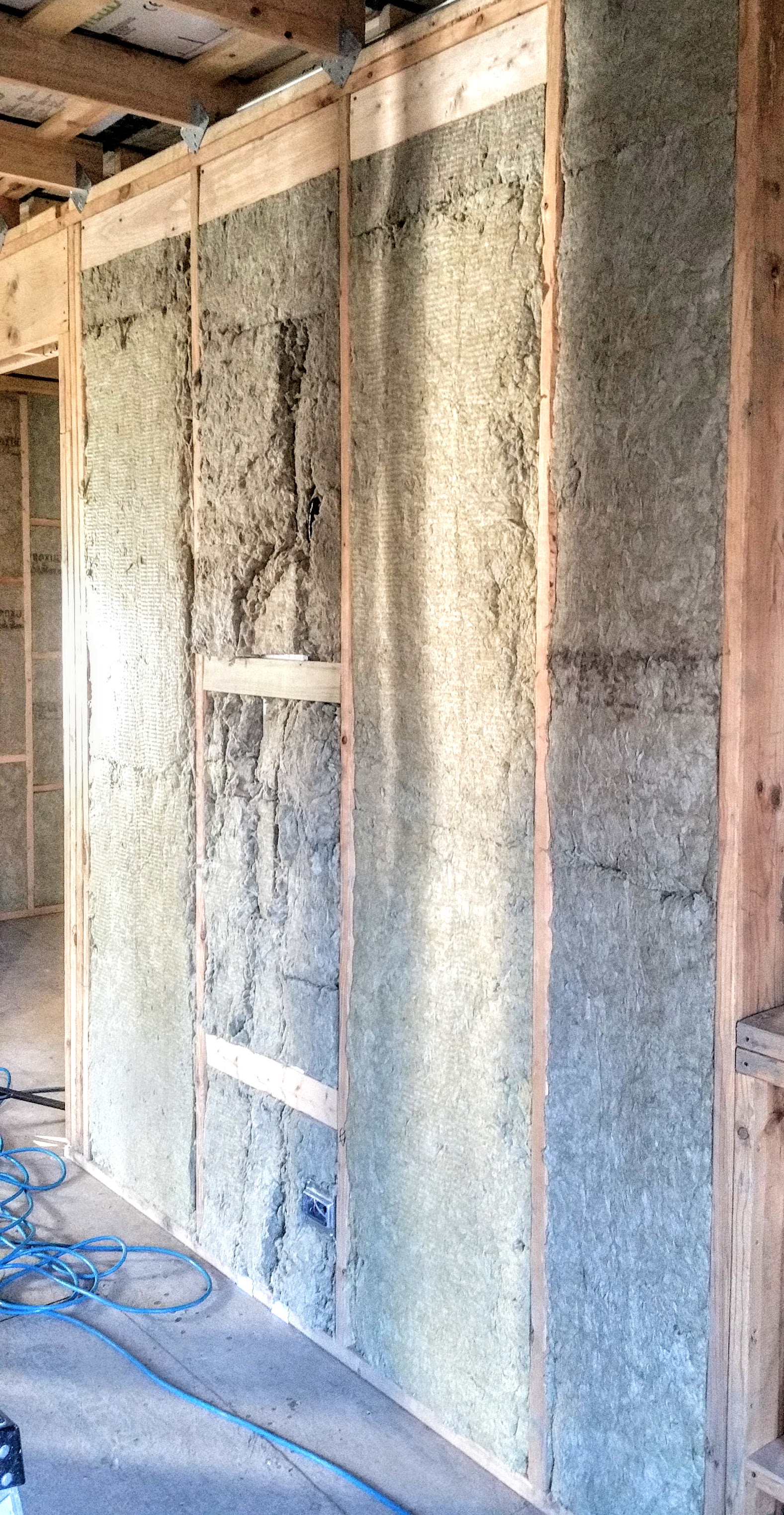
Here’s another view of this partition wall, this time from the opposite side inside the second bedroom:
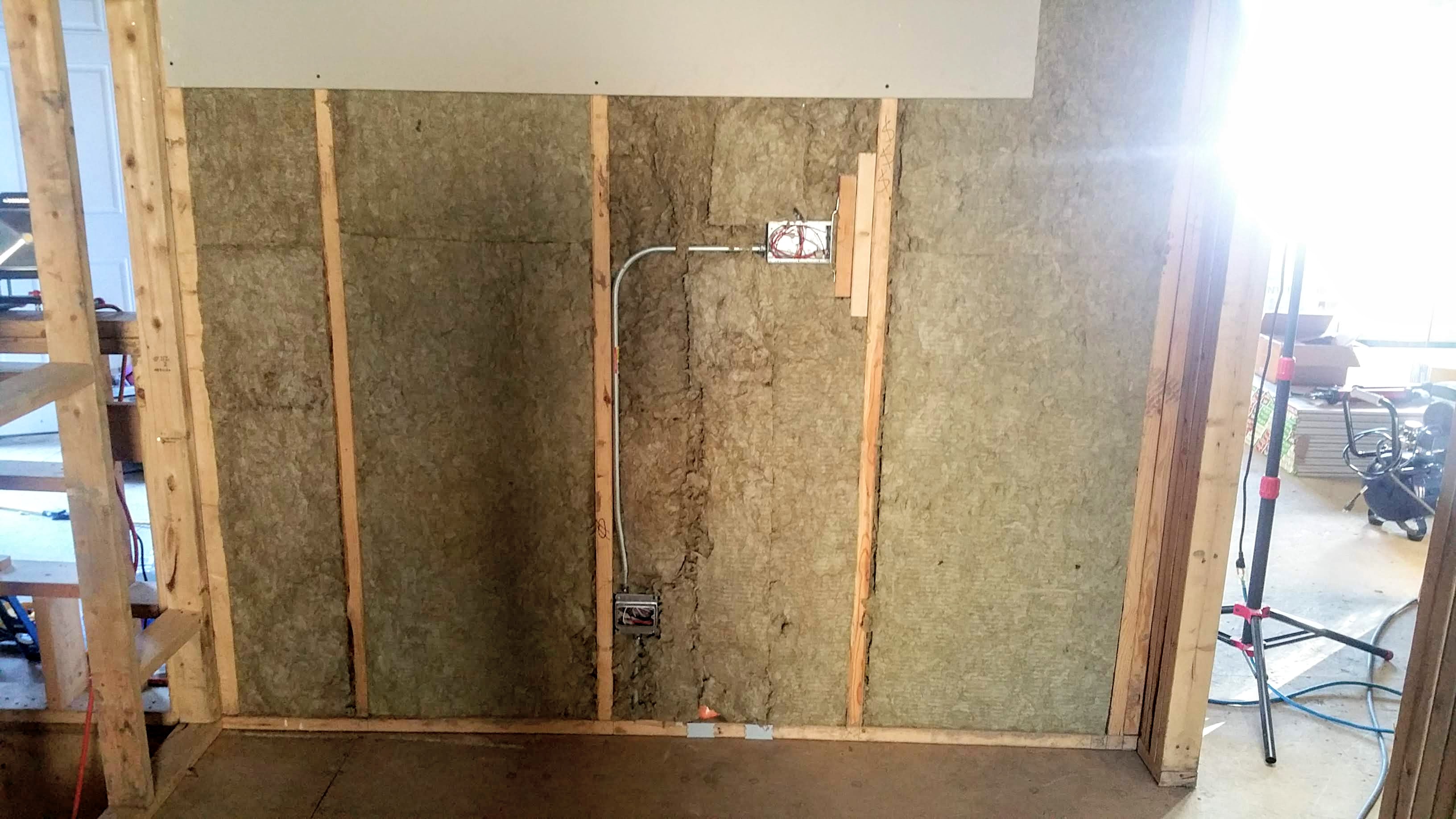
We also added Rockwool to the wall that connects the master bath to the 2nd bedroom bath, and between the 2nd bath and 2nd bedroom. The Rockwool was even added to the wall between our kitchen and utility room, where we have our washer and dryer, in the hopes that it would limit the amount of noise coming from the machines (which it thankfully has).
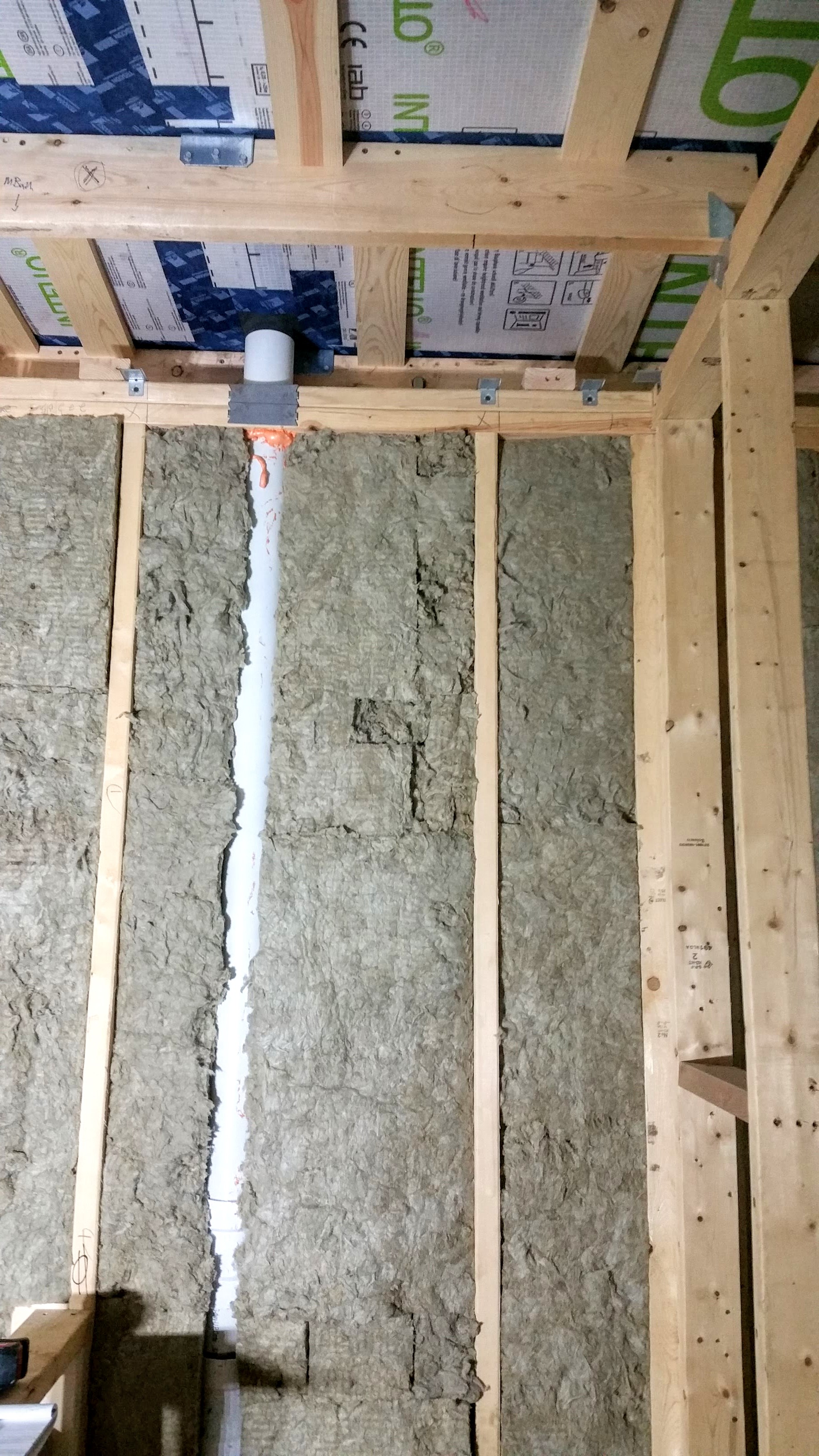
Although this doesn’t make for a totally sound proof connection between spaces (we weren’t prepared to take things that far — roughly equivalent to air sealing a Passive House in the amount of detail required), the ability of the Rockwool to significantly muffle sound between rooms is quite impressive and, for us at least, well worth the effort and added expense.
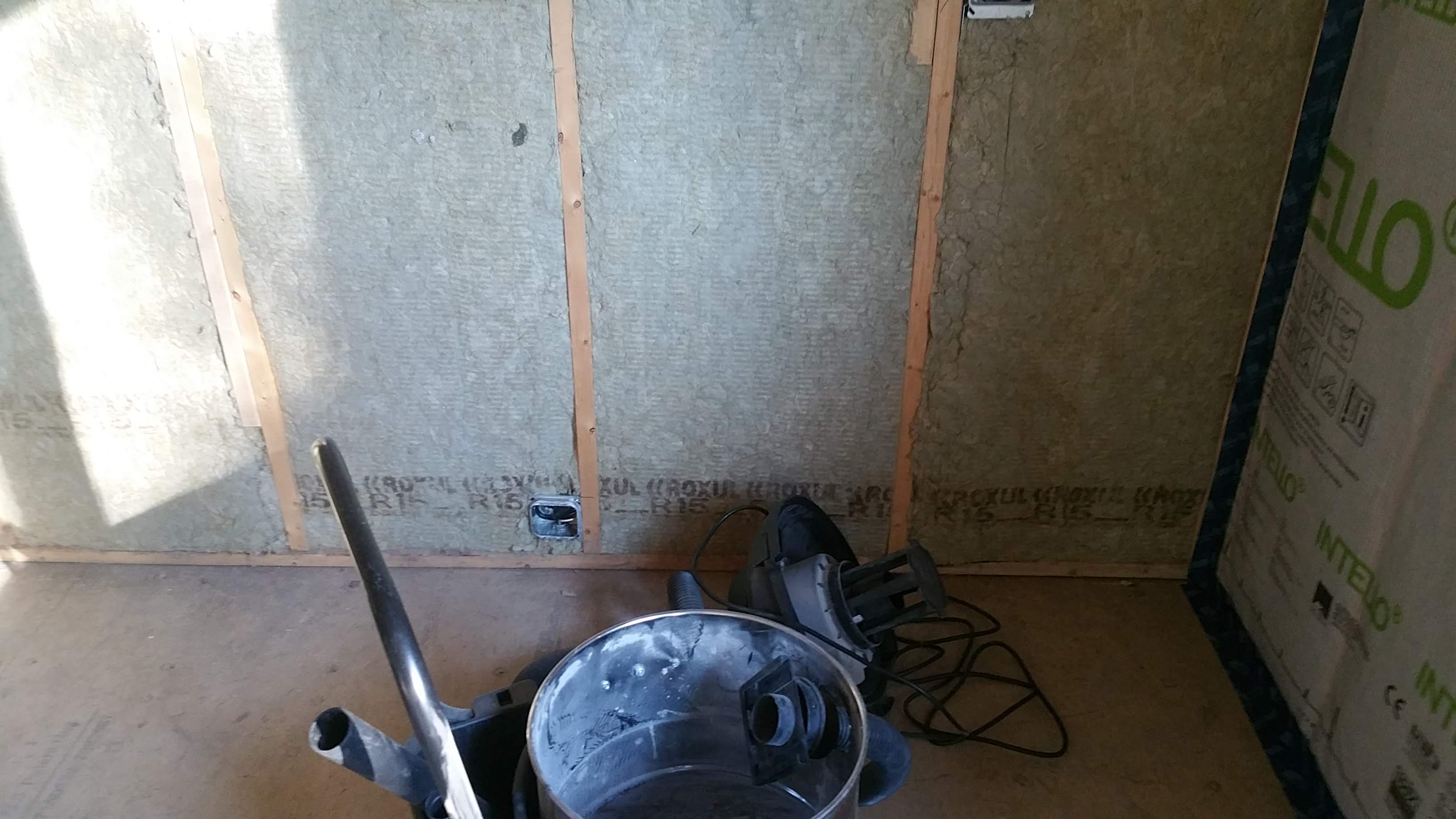
For instance, while standing in the master bathroom, should someone be running water or flushing the toilet in the 2nd bathroom directly on the other side of the wall, the majority of the sound that reaches your ear comes by way of the master bedroom doorway, not through the wall directly. Out of curiosity I tested this idea with music playing on a portable stereo in the 2nd bathroom with the same results — sound through the wall is dramatically muffled, while the same sound that easily travels out of the bathroom and makes it way via the bedroom doorway is crystal clear. With the door to the 2nd bathroom and our master bedroom door closed, this same sound is obviously further reduced.
It’s also nice to watch TV in the family room and know that as long as the volume is at a reasonable level you’re not disturbing anyone trying to sleep or read in the two bedrooms. This kind of sound attenuation also adds a level of privacy to the bathrooms while they’re in use.
And, again, it’s not that no sound is transmitted from one room to another, rather it’s almost entirely limited to doorways, thus significantly reducing the overall impact of the noise that is transmitted. In other words, our goal was rather modest, we were just after significant sound absorption, not sound proofing (e.g. the level of noise cancellation required in a professional recording studio or a high-end home theater room).
As a result, I would definitely use Rockwool for sound absorption again. In fact, I can’t imagine going without this kind of sound attenuation (or something akin to it using other products or techniques outlined in the videos above) now that we’ve been able to enjoy it in our new home. It effectively prevents the issues often associated with so-called “paper thin” walls.
Arguably, addressing this issue of unwanted sound transmission is even more important in Passive Houses or high-performance homes that are already much quieter than conventional homes because of the extensive air sealing and well above code levels of insulation. In our own case, outside noises either disappear entirely or are significantly muffled — this includes a commuter train a couple of blocks away.
As a result, any noises within the home itself become much more pronounced since they don’t have to compete with the typical noises coming from outside the home. For instance, when we first moved in the fridge in the kitchen was easily the most obvious, consistent sound in the house. After a couple of weeks it just became background noise we’ve grown to ignore, but it was surprising just how loud it was initially, especially our first few nights in the home when everything else was so quiet.
In addition to excessive air leakage and obvious temperature swings between rooms, along with poorly sized or placed window layouts, the lack of any sound attenuation between rooms is one of the issues we notice the most when we’re inside more conventionally built homes. Much like all of the conveniences associated with a modern kitchen, it’s easy to take something like effective sound attenuation for granted until you’re required to go without it (e.g. in the case of kitchens while on a camping trip or waiting for a kitchen to be remodeled).
With all of the Rockwool batts in place, and the Intello installed over the exterior walls, drywall could finally go up.
Drywall
We went with USG 5/8″ EcoSmart drywall (GBA article on EcoSmart). We chose the 5/8″ over 1/2″ mainly for added durability and some slight sound deadening between rooms.
I had read about Certainteed’s AirRenew drywall, but it sounded like the only VOC it absorbed was formaldehyde, which, if I understand the issue correctly, can be safely avoided with the use of appropriate cabinets and furniture. If memory serves, AirRenew works by utilizing a compound similar to triclosan, meaning a biocide, which some believe can have potentially serious health effects. It’s not clear to me, even now, whether the use of AirRenew drywall makes sense, or exactly what compound (or series of compounds) are utilized to absorb the formaldehyde since Certainteed has remained silent on this point, claiming the information is proprietary. Nevertheless, it has a Declare label, so ILFI must believe it’s reasonably safe to have on painted ceilings and walls.
At any rate, we wouldn’t be bringing in any new furniture that would have elevated levels of VOC’s (including flame retardants) once construction was complete. Since our last house was significantly larger, roughly 2,800 sq. ft., it was fairly easy to downsize, donating or giving away what we couldn’t use in our new house, while holding on to our favorite and most useful pieces. It also helped that we never really filled up our last house (e.g. we never got around to purchasing a formal dining room set), so we didn’t have as much “stuff” to discard as we might have.
Moreover, by being mindful of every finish we create or use (primers, paints, wood flooring, grout sealer, caulks and sealants, kitchen cabinets etc.), along with any other products we might bring into the new house (e.g. surface cleaners, new furniture, fabrics, even perfumes and colognes, etc.), we’re hoping to maintain a high level of IAQ.
The International Living Future Institutes’s Red List and their database of Declare products were a big help to us, even though we’re not pursuing any kind of certification with them. The Greenguard certified label was also helpful, in particular when it came time to choose tile and grout.
By consciously choosing every product and material that comes into the home, it’s possible to at least reduce our exposure to harmful VOC’s and chemicals. While still imperfect (Who can you trust?), these kinds of programs do allow designers and homeowners to take some control over the environments they’re creating and living in, which is empowering to a degree. Far better if the US regulatory bodies operated under a precautionary principle model when it came to industrial products.
Frankly, in a rational system, one that was truly looking out for the best interests of consumers, this kind of research — time consuming and frustrating busy work to put a finer point on it — would be considered laughable if not horrifying. In a rational system it would be safe to assume that any product for sale, apart from some careful instructions on their use and disposal, would be safe to have inside your home without having to worry about short or long term health implications.
Nevertheless, if unintended health consequences are to be avoided during a renovation or a new construction build, consumers have little choice but to do the necessary homework (or pay someone else to do it for them) and be as thoughtful as possible with their selection of materials.
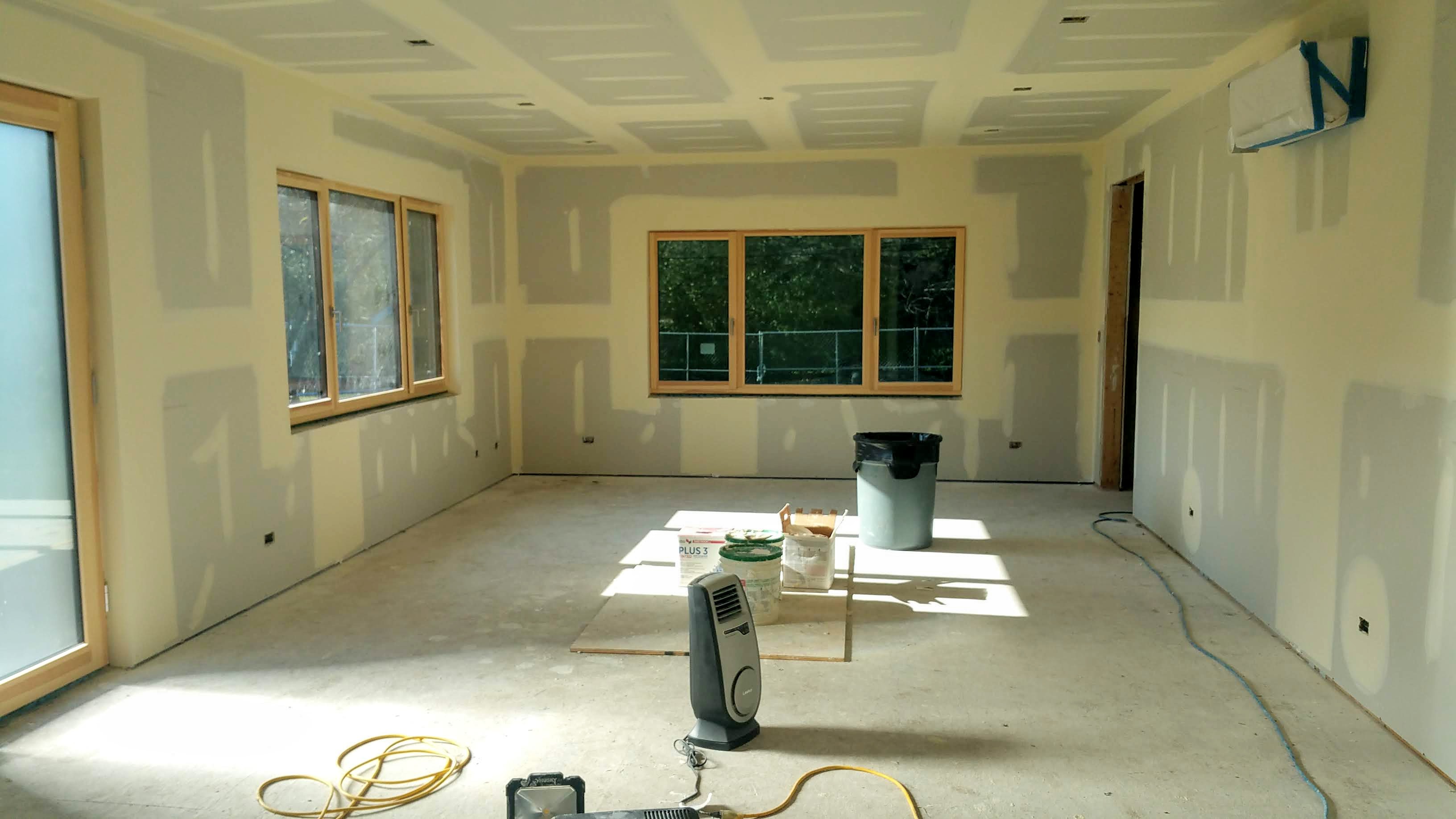
Now that all of the elements of our wall assembly were complete, it was time to have some fun with final finishes: flooring, wall colors, wood trim, doors, kitchen cabinets…


Thanks for this post. Regarding your interior sound work with Rockwool, it sounds like you are happy with its performance. Did you end up using hollow-core interior doors or solid core? We just moved into a new house (from a typical production builder) and the amount of sound that travels between rooms here is…ahem…uncomfortable.
LikeLike
Thanks for checking out the blog!
We limited the number of doors we used throughout the house in order to maintain an open, spacious feel.
We have 2 barn doors; one to close off the main bedroom, and a second one to add privacy for my daughter’s bedroom and bath areas.
In addition, we have a door to her bathroom and one for her bedroom. I custom made these out of leftover 2×6’s from framing, pocket screwing them together.
I’ll go into more detail on all of this in a couple of upcoming blog posts about how we designed the interior spaces.
We’ve been happy with the Rockwool for sound attenuation, particularly around bedrooms and bathrooms. This is especially helpful in a smaller home like ours, at only 1500 sf. Our large kitchen island is definitely the heart of the home, but even so, it’s nice to have the bedrooms to escape to, and having the Rockwool for sound deadening is a big help in this regard.
If I had it to do over, I’d probably take the time (and be willing to spend the money) to add a second layer of 5/8″ drywall along with green glue to improve the sound deadening even more between ‘public’ and ‘private’ spaces:
LikeLiked by 1 person
Excellent work on the wall assemblies! I have used GreenGlue on a ceiling assembly to reduce noise from the upstairs neighbors. I had positive results and would recommend it. I ended up using two layers of 5/8″ drywall and hanging them from the joists instead of screwing them directly to the joists.
LikeLike
Although the sound attenuation that I did has been working fine, if I had it to do over, I’d take the time to double up the layers of drywall around bedrooms and baths, along with using the Green Glue as you suggest. It could only improve things even more.
Thanks for checking out the blog!
LikeLike